Landmark Opinion Finds Public School Funding Inadequate

Also: Calm No Longer the Norm at School Board Meetings
The Second Amendment and Targeted K-12 School Shootings: An American Dilemma

SUMMER 2023
The Award-Winning Publication of the Berks County Bar Association



Delivering an award-winning CLE EXPERIENCE Live, Interactive Webcasts 800+ On-demand CLE Options Guide Books for Every Area of Practice Visit pbi.org/propass for more info. Get UNLIMITED Online CLE with ProPass and earn all your credits for one low price!
BOARD OF DIRECTORS

GABRIELA G. RAFUL, President
KAREN H. COOK, President-Elect
DANIEL C. NEVINS, Vice President
NIKOLAS D. CAPITANO, Secretary
PAUL F. TROISI, Treasurer
HON. TONYA A. BUTLER, Director
SARA R. HAINES CLIPP, Director
JAY M. KURTZ, Director

AMY J. LITVINOV, Director
LAUREN M. MARKS, Director
MARK E. ZIMMER, Director
JAMES M. SMITH, Immediate Past-President
LAUREN P. BUTTERWORTH, President YLS
BAR ASSOCIATION STAFF
KORI A. WALTER, Executive Director
ROSE M. JOHNSON, Law Journal Secretary/Office Manager
COURTNEY MORSTATT, Publications & Marketing Coordinator
LUCY BRITO, Community Service Manager
J. CHADWICK SCHNEE, Law Journal Editor
VALERIE KRAMER, Law Journal Assistant Editor

JAY M. KURTZ, Barrister Editor
Please submit materials or comments to: Berks County Bar Association

544 Court Street, P.O. Box 1058 Reading, PA 19603-1058
Phone: 610.375.4591
Fax: 610.373.0256
Email: info@berksbar.org
www.berksbar.org

Thank You
Our thanks are extended to the numerous people who have contributed to The Berks Barrister Your time, energy and efforts are sincerely appreciated.
Content for Summer 2023
Hoffmann Publishing Group, Inc. 2669 Shillington Road, #438 Reading, PA 19608 www.Hoffpubs.com Features: Departments:
Landmark Opinion Finds Public School Funding Inadequate
Calm No Longer the Norm at School Board Meetings
The Second Amendment and Targeted K-12 School Shootings: An American Dilemma 24 Legal Spirits Luau Party! 25 St. Patrick’s March Madness Party
The First Steps Towards Citizenship 27 Berks County Welcomes 45 New Citizens 28 Cornerstones of Democracy: Civics, Civility, and Collaboration 30 Halfway to the 15th Annual Holiday Benefit Luncheon 32 Taking Paths Less Traveled: One Lawyer’s Woodstock Journey 36 Remembering a Litigating Legend 40 Bench-Bar Conference 46 What You Need to Know Before You Give Money to Family 5 Opening Statement 34 Book Review 44 Restaurant Review 47 Closing Argument
8
15
18
26
No easy answers for stopping unauthorized practice of law
The past several months at the Bar Association have been loaded with meetings and projects that have filled my calendar and kept our members busy volunteering in the community. I am excited about all the things we have accomplished and the many things that will be done as we finish summer and head into the fall. As many of you are aware, I am action driven. That is why our agenda has been packed with activities for our members, opportunities for community engagement, and pro bono events. I am looking forward to updating members on our busy year during the Annual Meeting on Thursday, November 2 at the Berkshire Country Club. Please save the date and join us for that event.
There is one issue that concerns me and should concern our entire membership. That is the continuous, often brazen, unauthorized practice of law by many public notaries and other individuals who have no expertise – or legal authority – to charge clients for legal services.
The issue is not small, and the complaints we get barely reflect the chronic problem we know underrepresented communities and our profession are facing. During the last few months alone, our Bar Association has received the following complaints:

• Three family law practitioners have reported public notaries who have drafted
and notarized Separation Agreements where marital property and assets were divided. The agreements were drafted and notarized by a Notario Público and were later introduced as evidence in legal proceedings.
• One family law practitioner reported a divorce filing by a Notario Público. That same notary openly advertises in a store front window “Divorce from $395.”


• An elderly client who entered into a “Rentto-Own agreement” had paid over $20,000 and later learned that the landlord was not the owner of the property, and the agreement was not recorded. The agreement was drafted and notarized by a Notario Público.
• A client who complained about paying $3,500 to a Public Notary to complete a simple citizenship application – the same N600 form we completed at our April Naturalization Clinic, which takes an average of 1.5 hours to complete.
These are just some examples of individuals either trusting a public notary because they thought the notary was an attorney or where the unsuspecting client was ripped off by these individuals who have no business engaging in what clearly is the practice of law.
But why is this a problem and what has the Legislature done to combat the issue?
Continued on page 7
Opening Statement
www.BERKSBAR.org
Gabriela G. Raful, Esquire 2023 President
Confidence for the long term.
Our long-term perspective and counseled insight provide the confidence investors need in today’s challenging environment. As a registered investment advisor, our fiduciary responsibility is only to you and the best interests of your investments.

Count on our qualified professionals for the trust, tenure and talent you can take confidence in—for the long term.
Smith Bukowski is welcoming applications for an experienced Litigation Attorney with a desire to establish a long-term relationship with our firm and the communities we serve.


We are located in Wyomissing, Berks County, Pennsylvania. We are a general practice firm representing businesses and individuals throughout eastern Pennsylvania in practice areas that include civil litigation (in state and federal courts and administrative agencies), business transactions and counseling, real estate and land use issues, and estate planning and administration. Other practice areas and information about our firm can be found at our website: www.SmithBukowski.com. The ideal candidate will have five or more years of litigation experience. Salary and responsibility will be commensurate with experience, but we have every reason to believe that the ideal candidate will earn an annual salary ranging from $100,000 - 150,000.
To apply, email your cover letter, resume, and a writing sample to our Firm Administrator at KKoslesky@SmithBukowski.com.
Schuylkill River Greenways wanted help with the preservation and revitalization of the river and a 120-mile trail alongside it, they looked to Tompkins because of our shared commitment to traditional values and economic innovation. | tompkinsbank.com
6 | Berks Barrister Integrity, Service, Performance. 610-376-7418 • connorsinvestor.com
ELAINE SCHAEFER SCHUYLKILL RIVER GREENWAYS preservation or progress I chose both Deposit and loan products are offered through Tompkins Community Bank, Member FDIC. Investments and insurance products are not FDIC insured, are not bank guaranteed, and may lose value. Tompkins Insurance is licensed to conduct insurance business in all 50 states. 4/23 When
In Latin American and some European countries, a public notary must be a lawyer before obtaining a notary license. Hence the confusion. Individuals from countries where notaries are attorneys are easy prey. Upon seeing a title such a “Notario Público” or “Notario” sign or advertisement, an individual from one of those countries is likely to believe that they are dealing with a lawyer. Reading’s population is predominantly Latinx, and, as a result, many public notaries take advantage of those who, simply put, do not know better.
I do recognize that the issue is not one of just misrepresentation by notaries but also one of access to attorneys. Language barriers and affordability of legal services are obstacles that lure Latinx members of our community to public notaries.
In 2013, the Revised Uniform Law on National Acts (RULONA) was signed into law with language that specifically addressed fraudulent business practices employed by many Public Notaries in minority and underserved communities. The law prohibits notaries from advertising as “Notario Público” and “Notario.” Specifically, RULONA makes clear that a notary cannot assist persons in drafting legal records, give legal advice, or act as an immigration consultant.
In 2015, the City of Reading passed an ordinance requiring notaries to post visible notices stating that they are not lawyers and are not certified to give legal advice or represent clients.
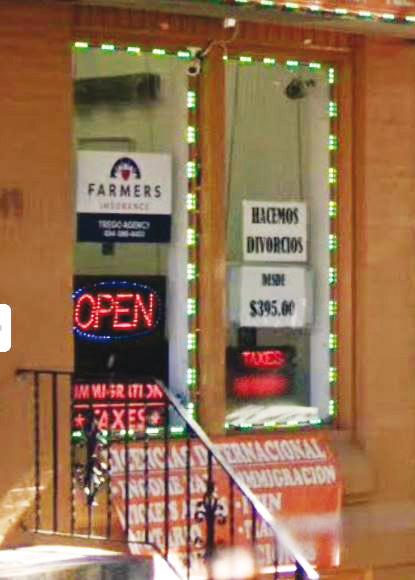
Despite the City of Reading’s ordinance and RULONA, many, many public notaries utilize their license and title to perpetuate fraud and engage in the unauthorized practice of law. Some go to the extent of not just advertising that they do “Divorce from $395” but also help with “Pro Se Document Services, Divorce, Deeds, Wills, QDROS, Contracts & More Legal Plans.”
Historically, the Berks County Bar Association and the Pennsylvania Bar Association have taken steps to educate individuals in the community and the public notaries. Both associations have referred matters to the Attorney General’s office. Over the years, we have partnered with churches and the Latino Chamber of Commerce in providing education as to the scope and limits of public notaries.
In 2005, Jill Scheidt filed suit on behalf of the BCBA against a notary who had been practicing law. As a result of Jill’s work, the court fined the notary $5,000. In 2008, a city notary was prosecuted but was found not guilty by reason of insanity on charges of unauthorized practice of law.
Jill Scheidt, who has served as Chair of the Unauthorized Practice of Law Committee in our Bar Association and Vice Chair of the PBA’s Unauthorized Practice of Law Committee, explained in a 2014 interview with the Reading Eagle that the problem is not only the notaries but also driven by the clients who turn to the notaries for legal services.
She is right. In each of the complaints described above, our members have asked the victims to come forward and report this crime. Too often, the clients are reluctant to cooperate despite the fact that they spend more money to have a licensed attorney clean up the mess created by a notary.
The unauthorized practice of law is not limited to only notaries. While these cases are often seen in Landlord Tenant and Family law matters, it is a problem that affects all practitioners. Don Smith wishes he could perform a citizen’s arrest! Recently, he had a case where a “beneficiary trustee” represented the landlord. After arriving late for the arbitration, the Trustee demanded a jury trial. And then erroneously filed several motions and other pleadings. Don questions “Should I be filing an answer to these frivolous motions? A damn headache!”
And yes, while Don did not pursue the citizen’s arrest, his point is well taken. How often will we as lawyers, along with our clientvictims, continue cleaning up the messes made by these individuals who have no business taking clients’ money to provide legal assistance without a license in Pennsylvania? Notaries and other non-lawyers do not carry malpractice insurance and, generally, are unaccountable when they make mistakes that may deprive clients of property and certain legal rights.
So, what more can be done?
When I opened the column, I noted that my personality is action driven, yet I’m hard-pressed to find a solitary action that will solve this complex problem. We truly need the individuals who are directly affected by this fraud – the victims – to come forward and report the conduct every time it occurs, not just a few times every few years. Attorneys also need to be vigilant. We need to take the extra time to explain to victims the process of reporting violations of Reading’s ordinance and the RULONA advertising restrictions not just to the Bar Association but to local police, the district attorney, and even the Pennsylvania Attorney General.

Yes, we need to handhold the client, show them they can trust the system, and help them report these abuses and unauthorized practice of law. Community awareness is key, and at the bar association, we will continue providing community outreach and education on public notary fraud. However, having victims being able to share their stories with other community members and with the authorities is even more important.
It is incumbent on all attorneys to respect our profession enough and to appreciate the value we provide in representing our clients enough to take extra time and assist individuals in reporting the unauthorized practice of law.
www.BERKSBAR.org
from page 5
www.BERKSBAR.org Summer 2023 | 7
Continued
Opening Statement
Landmark Opinion Finds Public School Funding Inadequate


8 | Berks Barrister www.BERKSBAR.org
By Pamela L. VanFossen,
Mold. Asbestos. Lead paint. Leaking roofs. No heat or air conditioning. Twenty-year-old textbooks shared by classes. Teachers teaching multiple courses simultaneously in hallways and broom closets. School buildings without nurses, counsellors, librarians, or reading specialists. Students lacking the foundational skills to take advanced courses on rare occasions when there are available slots in those classes and if they can be staffed.
While this may sound like a dystopian exaggeration, the conditions are a reality for many students and educators in Pennsylvania public schools, according to a 773-page Memorandum Opinion issued by the Commonwealth Court.


And now, as explained in the landmark decision, such conditions are not just abysmal – they are unconstitutional.1
The verdict had been a decade in the making, having originally been filed in 2014 by six school districts and parents and two statewide organizations.
The Commonwealth Court found that the educational experience provided in our low-income districts is an unconstitutional violation of the Education Clause of the Pennsylvania Constitution and a violation of our students’ Equal Protection rights. How the situation will be remedied is uncertain, as the Court did not impose a specific remedy, but one thing is certain: change is mandated.


The matter generated quite a bit of press coverage during the 49-day trial before the Commonwealth Court (a rare instance of a matter being brought directly there pursuant to original jurisdiction) and resulted in 15,000 pages of transcripts and nearly 1,700 exhibits.
TEN YEARS IN THE MAKING
In 2014, the Petitioners brought suit before the Commonwealth Court, arguing that the Commonwealth has failed to provide for the “maintenance and support of a thorough and efficient system of public education to serve the needs of the Commonwealth” as required by the Education Clause of the Pennsylvania Constitution.2 The Respondents (including the Pennsylvania Department of Education, the State Board of Education, the President Pro-Tempore of the Pennsylvania Senate, the Speaker of the Pennsylvania House of Representatives, the
Continued on next page
Summer 2023 | 9 www.BERKSBAR.org
The Commonwealth Court defines public education as a fundamental right and finds that funding falls short of fulfilling that right for many poor districts.
Esquire
Landmark Opinion Finds Public School Funding Inadequate

Continued from page 9
Governor, and the Secretary of Education) were initially successful in having the suit dismissed on preliminary objections. The Pennsylvania Supreme Court, however, reversed and remanded. After the remaining preliminary objections were denied, the parties engaged in two years of discovery before proceeding to trial.
At issue was the Petitioners’ contention that low-wealth districts, “which frequently serve higher need students, are not on a level playing field with higher-wealth districts, such that the current funding system violates equal protection principles.”3 Pennsylvania’s Constitution has contained provisions for a public school system since 1776, with the “thorough and efficient” language first adopted in 1874.4
The Education Clause of the Pennsylvania Constitution guarantees students a “full or complete system of public education that is effective in producing students who, as adults, can participate in society, academically, socially, and civically, which thus serves the needs of the Commonwealth.”5 To determine whether the current system meets that requirement, the Court found that “the appropriate measure is whether every student is receiving a meaningful opportunity to succeed academically, socially, and civically, which requires that all students have access to a comprehensive, effective, and contemporary system of public education.”6 While the state need not provide a uniform system state-wide, to pass constitutional muster, opined the Court, the educational opportunity provided needs to be “comprehensive, effective, and contemporary.”7
For the legal historians, the Court outlined the Commonwealth’s constitutional history regarding the Education Clause, including our forebearers’ thoughts on the value of public education, like this one from Governor George Wolf in 1830: Of the various projects which present themselves, as tending to contribute most essentially to the welfare and happiness of a people, and which come within the scope of legislative action, and require legislative aid, there is none which gives more ample promise of success, than that of a liberal and enlightened system of education, by means of which, the light of knowledge will be diffused throughout the whole
community, and imparted to every individual susceptible of partaking of its blessings; to the poor as well as to the rich, so that all may be fitted to participate in, and to fulfil all the duties which each one owes to himself, to God, and to his country. The constitution of Pennsylvania imperatively enjoins the establishment of such a system. Public opinion demands it. The state of public morals calls for it; and the security and stability of the invaluable privileges which we have inherited from our ancestors, require our immediate attention to it.8
Having outlined why the suit could be brought, the Court turned to consideration of how to determine whether a constitutional violation had occurred. Unsurprisingly, the parties disagreed on what criteria should be considered by the Court. The Respondents argued that only the “inputs” a district provides should be considered in evaluating the constitutionality of the system, as the “outputs”, i.e. – test scores and other quantifiable metrics – involve multiple factors outside of the school’s control, such as the student’s home life. The Petitioners argued that both are relevant and meaningful.
The Court rejected an outputs-only analysis and engaged in a thorough examination of both factors, finding that without doing so “there would be no way to gauge the adequacy of the system, and whether it is working to provide the opportunity to succeed to all students.”9 Analyzing both, the Court found that students in certain Pennsylvania schools are not receiving a meaningful opportunity to succeed.
UNDERFUNDED SCHOOLS ARE DEFICIENT
While the Court expressly stated it took no pleasure in pointing out the deficiencies of the system,10 it systematically and unflinchingly laid bare both the realities facing districts and the holes in the Respondents’ arguments. It elected not to comment on a controversial line of questioning from counsel for the Senate President Pro-Tempore wherein he seemingly scoffed at standards mattering for students entering certain professions, asking a witness, “What use would someone on the McDonald’s career track have for Algebra 1?”
The question went viral – although any reference to it was absent from the Court’s analysis.11 It was hardly needed to make the Court’s point. Instead, the Court imbedded charts of hard data and photographs of crumbling, overcrowded schools introduced during the trial to illustrate its findings.
The Legislative Respondents argued that there was no evidence that “low-wealth school districts lack the basic instrumentalities of learning, again noting that several Petitioner Districts have recently revised their curricula and purchased new materials, including textbooks and online instructional tools.”12 They asserted that no evidence was presented that any such district “lacks desk, chairs, tables, or writing materials.”13
To the contrary, the Speaker asserted that “not only are lowwealth districts in Pennsylvania, including Petitioner districts,
10 | Berks Barrister www.BERKSBAR.org
able to offer a basic education to their students, they offer opportunities that go far beyond.”14 Any evidence of insufficient funding, the Respondents asserted, was specious.15 The President Pro-Tempore also asserted that districts are not spending their funding in a cost-effective manner or were maintaining large balances16 in an attempt to undercut the Petitioners’ causation evidence. The Court rejected these arguments.
FIVE PRONGS OF ADEQUACY IN EDUCATION
The Court reviewed five inputs it found critical to any determination of the constitutional adequacy of the school system: 1) funding; 2) courses, curricula, and other programs; 3) staffing; 4) facilities; and 5) instrumentalities of learning.
Regarding funding, the Court found that “low-wealth districts cannot generate enough revenue to meet the needs of their students, and the pot of money on which Legislative Respondents allege they sit is not truly disposable income.”17 It found that studies and formulas employed by the state to analyze and rectify funding issues establish “the existence of inadequate education funding in low-wealth districts”.18

On the topic of the large fund balances highlighted by the Respondents, the Court found that balances are required by state rules and are not actually “expendable dollars.”19 The Court went on to state that balances were also advisable to enable the district to continue to operate when funding is delayed, there are unexpected expenses, and to obtain loans. At least one such balance was earmarked for sewage system repairs, and another was planned to replace infrastructure and technology. Several districts had almost zero balances in their accounts, and but for recent temporary COVID funding, would have had a negative balance, or were only in a better financial position due to “draconian” cuts they made.20
A parade of broken promises or illusory offerings filled the Court’s analysis of the courses and curricula offered by low-wealth districts. Electives are not offered, teachers are simultaneously teaching different levels of the same subject at the same time in the same classroom, or are teaching different courses simultaneously, and students are unable to take courses because of limits on enrollment due to space or money.21 Courses are cut when temporary funding runs out.22 Elective courses like art and music are cut or are often canceled because the school lacks adequate staffing for the day and moves those teachers to core subjects.23
Curriculum fails to meet state standards because the district lacks the money, personnel, and time to revise them.24 AP classes are out of reach because districts are forced to charge parents in the poorest district in the state for the cost of the course.25 Advanced classes are also out of reach for students because districts lack the resources to prepare students for AP work, from elementary school on.26
The Court also outlined a lack of reading specialists, psychologists, behavioral interventionalists, tutors, after school programs, support services, and high-quality pre-K, to name a few.27 Of note, the Respondents did not deny the importance of programs like athletics, art and music, and other educational programs which the Petitioner districts lack.
Continued on next page
Offers:
• Comprehensive outpatient evaluations conducted by a therapist trained in substance use disorders.
• A range of outpatient group counseling options for teens and adults.


• Individual counseling.
• Trauma Services.
• Critical support for family members.
• Specialized addiction program.
• Prevention and education programs.
• Recovery support for alumni.
Summer 2023 | 11 www.BERKSBAR.org
WWW.CARON.ORG CARON OUTPATIENT TREATMENT CENTER Located in Wyomissing, Pennsylvania 845 North Park Road Wyomissing, PA 19610 484-345-4670
Landmark Opinion Finds Public School Funding Inadequate
Continued from page 11
Staffing levels, according to the Court, are hampered by turnover, attrition, and frozen salaries.28 Specialized professionals like guidance counselors, social workers, nurses, psychologists, reading specialists, librarians, and instructional aides are staffed at “an insufficient quantity to actually meet students’ needs, or [are] funded through outside sources of one-time [emergency COVIDrelief] funds, which districts have been cautioned against using for such purposes.”29
According to the Court, the large class sizes presented by the Petitioners “undermine student success.”30 Rejecting the legislature’s evidence of student-teacher ratio and studentpersonnel ratio as “misleading,” the Court found that studentteacher ratios include non-regular classroom teachers where there are few students, and it chose instead to accept the Petitioners’ evidence of classroom size.31
The Court’s findings regarding facilities were particularly striking, if not surprising. Drawn from the Petitioners’ case, the Court paints a compelling picture of makeshift classrooms in hallways, closets, and basements, insufficient restrooms to serve the population, schools without functioning heat and air conditioning, crumbling concrete, desks under electrical boxes, leaking roofs, lead paint, mold, asbestos, non-potable water, and falling masonry.32
Even textbooks, the most fundamental of school supplies, are not up to par in the Petitioner districts. Schools lack enough of them to give each student one, forcing them to share, and those they have are severely outdated. Bill Clinton is still president in some, and they list countries which no longer exist.33 Technology like Chromebooks have been donated or purchased with temporary funds which, once the funds run out, the districts have no resources to maintain.
POVERTY IS NOT AN INDICATOR OF ABILITY
Perhaps much of this could be forgiven if low-income schools were still turning out students prepared to excel after graduation, but the Court’s review of data compiled from PSSAs and Keystone Exams (two standardized tests Pennsylvania students take on a yearly basis) show significant achievement gaps between students who attend low-income districts as compared to those in more affluent districts.34 One fact stands out in this section, even amongst the parade of failings – “[b]ecause of these existing gaps, the Department set lower goals in its ESSA Plan for future achievement for children of color than it set for children who did not fall into a subgroup.”35
The Court considered disproven the argument, often only advanced in whispers, that maybe certain students simply cannot reach high academic goals. To the contrary, the Court highlighted and accepted the Petitioners’ data which showed that students from low-income families who attend affluent districts outperform their peers in less wealthy districts by sixteen to twenty percent.36
“[H]istorically underperforming students in high-wealth districts outperform their peers in low-wealth districts, 45.1%
to 25.2%.”37 The Court was clear and emphatic in the meaning of these statistics – “money does matter, and economicallydisadvantaged students and historically underperforming students can overcome challenges if they have access to the right resources that wealthier districts are financially able to provide. . . . In short, these statistics confirm what numerous witnesses testified as to: every child can learn, regardless of individual circumstances, with the right resources, albeit sometimes in different ways.”38
The Court also articulated what it believes to be the cause of these unacceptable conditions without hesitation – “[l]owwealth districts across the state are forced to make [ ] difficult decisions because, although the Education Clause imposes a duty on the General Assembly to maintain and support a thorough and efficient system of public education . . . the system is heavily dependent on local tax revenue, which the lower wealth districts cannot generate like their more affluent counterparts.”39 It seems that a happy byproduct of this decision will be reform of the property tax system which has imposed such a burden on so many across the Commonwealth.
PUBLIC EDUCATION IS A FUNDAMENTAL RIGHT
Having found that the Commonwealth is violating the Education Clause, the Court then turned to the Petitioners’ Equal Protection claims. A matter of first impression, the Court found that the Education Clause created a right to a public education in the students, not just a duty on the part of the Commonwealth. In light of the history and text of the Clause, the Court found for the first time that the right to a public education is a fundamental right either explicitly or implicitly derived from the Pennsylvania Constitution.40 Accordingly, alleged “impingement” on the right should be evaluated under strict scrutiny.41
The Court found the legislature’s justification of the current funding scheme – “promot[ing] local control” – unpersuasive.42 Precedent has already established that “the need for local control cannot relieve the General Assembly of its exclusive obligation under the Education Clause,” and the Court used precedent from another jurisdiction to explain that “to alter the state financing system to provide greater equalization among districts does not in any way dictate that local control must be reduced. . . . Second . . the notion of local control was a ‘cruel illusion’ for the poor districts due to limitations placed upon them by the system itself . . . Far from being necessary to promote local fiscal choice, the present system actually deprives the less wealthy districts of the option.”43
Unable to raise tax dollars themselves, poor districts face the proverbial “Hobson’s choice,” despite the state’s extensive mandates governing public education.44 Local power, according to the Court, is meaningless without funding.45 The Court found that the state has transferred “the majority” of its obligations onto the local districts. In the absence of a compelling reason therefore, the Court found that the Commonwealth is violating the Equal Protection Clause of the Constitution. Notably, even applying
12 | Berks Barrister www.BERKSBAR.org
Continued on page 14










Summer 2023 | 13 R Protecting Your Practice is Our Policy.® Conventional wisdom says, “Don’t put all your eggs in one basket.” MLM thinks otherwise. Lawyers’ professional liability insurance is all we do. As a result of doing one thing, we do that one thing well. Get a Quote Today! Jody Campbell 215-872-8026 jcampbell@mlmins.com www.mlmins.com At MLM “here today, here tomorrow” is more than just a motto and our financial strength is your best defense. LET’S TALK BUSINESS. WE’RE HERE TO HELP YOUR BUSINESS THRIVE. Staying on top of your finances can be a daunting task. But with Members 1st on your side, it doesn’t have to be. We offer a full suite of digital tools and time-saving services that make managing your business easier than you ever thought possible. *Must meet current eligibility requirements. Federally insured by NCUA. BECOME A BUSINESS MEMBER TODAY. * MEMBERS1ST.ORG David R. Beane, Esquire Swanona At Historic Centre Park 606 North Fifth Street, Suite 7 P.O. Box 1339 Reading, Pennsylvania 19603 Tel: 610.378.5555 Fax: 610.378.5551 drb@beanellc.com www.beanellc.com Helping the Regulated Community Manage Environmental Risk and Solve Environmental Problems Peter K. Heim Associate-Broker office: 610-898-1441 cell: 610-745-3378 email: pheim@kw.com www.peterheimrealtor.com Our Home is Worth What? Know the value of your home? Find out today with this free, no-obligation search from Berks County’s most trusted Realtor. Native Berks Countian, Peter Heim is an award-winning Real Estate Broker with more than 35 years of experience.
Landmark Opinion Finds Public School Funding Inadequate
Continued from page 12
intermediate or rational basis scrutiny, the Court indicated that it would still find a violation.
SEARCHING FOR ANSWERS
So, what then is the remedy? The Court, perhaps wisely, declined to fashion one itself. The Court mandated only that the state must ensure that every student receives a meaningful opportunity to succeed “academically, socially, and civically, which requires that all students have access to a comprehensive, effective, and contemporary system of public education.”46 How they do that is their decision.47 As such, the Court was willing to give the Legislative and Executive branches, along with their administrative agencies, “the first opportunity” to work with the Petitioners to “devise a plan” to fix the issue.48 The options for reform, the Court opined, “are virtually limitless.”49
The Order imposed no timeline for state performance. Instead, the Court left the parties with this closing statement: “All witnesses agree that every child can learn. It is now the obligation of the Legislature, Executive Branch, and educators, to make the constitutional promise a reality in this Commonwealth.”50
NO APPEAL HAS BEEN FILED
To date, no appeal has been filed. As a result of post-verdict motions, the thirty-day deadline to do so has not expired as of this writing, although some advocates involved in the case have cautiously expressed that they do not expect one.
Now-Governor Shapiro, who filed an amicus brief in support of the Petitioners as Attorney General, along with former Reading School District Superintendent and now Education Secretary Khalid Mumin, are expected by the Petitioners’ counsel to be “partners in getting to work.” Governor Shapiro’s first budget included a proposed
1 William Penn Sch. Dist.; Panther Valley Sch. Dist.; The Sch. Dist. of Lancaster; Greater Johnstown Sch. Dist.; Wilkes-Barre Area Sch. Dist.; Shenandoah Valley Sch. Dist.; Jamella and Bryan Miler, parents of K.M., a minor; Tracey Hughes, parent of P.M.H., a minor; Pennsylvania Assoc. of Rural and Small Schools; and The National Association for the Advancement of Colored PeoplePennsylvania State Conference, Petitioners v. Pennsylvania Dept. of Ed.; Kim L. Ward, in her official capacity as President Pro-Tempore of the Pennsylvania
Senate; Mark Rozzi, in his official capacity as the Speaker of the House of Representatives; Josh Shapiro, in his official capacity as the Governor of the Comm. of Pennsylvania; Pennsylvania St. Bd. Of Ed.; and Dr. Khalid N. Mumin, in his official capacity as Acting Secretary of Education, Respondents, 2023 WL 1990723, p. 3. (hereinafter “Op.”)
2 Op. p. 2.
3 Op. p. 2.
4 Op. p. 18.
5 Op. 632-33.
6 Op. p. 634 (emphasis in original).
$567 million increase in general education funding, a $103.8 million increase in special education funding, and $100 million for remediation of environmental hazards in schools.51 It did not change the way the state distributes funding, and the governor called it a “down payment” with next year’s budget intended to increase funding and address the equitability of distribution. Critics note that the large figures track inflation and oppose his recent support of vouchers.
Additionally, the state Basic Education Funding Commission, which is a bicameral, bipartisan group of legislators and appointees, has been tasked with creating a new, more equitable funding formula. The Commission is currently holding hearings, with the next meeting scheduled mid-July.52 The Committee’s recommendations will still need legislative approval, although it does have a positive track record, as it is the same Commission which created Governor Wolf’s improved educational funding formulation.
The significance of the Court’s acceptance of the harsh realities facing educators across the Commonwealth cannot be overstated, especially in our time of “alternate facts.” The decision may give a glimmer of hope to weary education professionals, even if experience tells them not to expect too much.
The political wheels will undoubtedly continue to grind slowly, but for the first time in a very long time, the fortunes of low-income districts may be forced to change. As so much of our collective future depends on how we address this issue, we should all continue to watch closely.
7 Op. p. 636.
8 Op. p. 10.
9 Op. p. 707.
10 Op. p. 777.
11 The Morning Call, Five Takeaways From Pennsylvania’s Landmark School Funding Trial After One Month, THE MORNING CALL, December 27, 2021, https://www.mcall. com/2021/12/27/ five-takeaways-frompennsylvanias-landmarkschool-funding-trial-afterone-month/.
12 Op. p. 653.
13 Op. p. 654.
14 Op. p. 654.
15 Op. p. 654.
16 Op. p. 655, 680.
17 Op. p. 681.
18 Op. p. 678.
19 Op. p. 680.
20 Op. p. 680-81.
21 Op. p. 681.
22 Op. p. 682.
23 Op. p. 682.
24 Op. p. 683.
25 Op. p. 683.
26 Op. p. 684.
27 Op. p. 686-87.
28 Op. p. 690.
29 Op. p. 695, 696.
30 Op. p. 691.
31 Op. p. 693.
32 Op. p. 698-702.
33 Op. p. 704-05.
34 Op. p. 712-713.
35 Op. p. 715.
36 Op. p. 716-17.
37 Op. p. 717.
38 Op. p. 717-718 (emphasis in original).
39 Op. p. 697-98.
40 Op. p. 747.
41 Op. p. 763.
42 Op. p. 770.
43 Op. p. 769-70.
44 Op. p. 772.
45 Op. p. 772.
46 Op. p. 776-77.
47 Op. p. 776.
48 Op. p. 775-76.
49 Op. p. 776.
50 Op. p. 778.
51 Marley Parish, Shapiro touts proposed K-12 spending as ‘a real downpayment on the future of education’, PENNSYLVANIA

CAPITAL STAR, March 15, 2023, https://www. penncapital-star.com/ education/shapiro-toutsproposed-k-12-spending-asa-real-downpayment-onthe-future-of-education/.
52 Eric Scicchitano, Hearing focuses on new formula, READING EAGLE, June 9, 2023.
14 | Berks Barrister
Ms. VanFossen is an attorney with the Wyomissing firm Masano Bradley.
www.BERKSBAR.org
Calm No Longer the Norm at School Board Meetings

Solicitors, board members, and an advocate discuss dealing with conspiracy theories, culture clashes, and political division
By Joan E. London, Esquire and Brian J. Boland, Esquire
The Municipal, Education, Real Estate and Environmental Law Section had the privilege of presenting a session at the Bench-Bar Conference on school board practice. Months earlier, as plans were underway for the Conference, the Section decided that the cultural, political, and governance developments of the prior three years would lend themselves to a thoughtprovoking panel discussion. We were not disappointed.
School boards had for years been fairly calm, with meetings marked by routine questions on hiring of professional and support staff and meeting needs for facilities to accommodate shifts in population. Since 2020, and the COVID-19 shutdown of the schools and shift to virtual learning for almost two years, public schools and school boards became one of the key battlegrounds over cultural debates and political values. Discussions of policies, curriculum, library books, and use of bathroom and locker room facilities, fueled by social media and the prevalence of national and regional organizations, have been happening with more frequency, and are only becoming more heated.
For our session titled “The School Board: Curriculum, Books, and Culture,” I assembled an ideologically balanced panel of attorneys who are involved in school law in different capacities. The local panelists were Brian F. Boland, John J. Miravich, and Dawn Palange. The panel also included Jeremy Samek, an attorney with Independence Law Center in Harrisburg, who regularly represents clients in matters involving school policy. We had invited a litigator from ACLU-PA, who accepted our invitation, but he unfortunately was unable to participate due to illness. We started the discussion with some real-world scenarios:
Imagine it's 2020-2021. You’re a parent who works outside the home. The schools are on indefinite remote learning, and child care is cost-prohibitive if you can find it. The school board is gathered pre-meeting, not realizing that the virtual meeting link is on, and the members are speaking freely. The head of a teacher’s union is heard disparaging parents with: “They just want their babysitters back” and the school board members are laughing along with it.
OR
You’re a parent of a child with a chronic health condition. The angry residents at the meeting are making it clear they want schools open NOW – and no masks – because COVID doesn’t badly affect healthy children and adults. You ask the question: “Is my child disposable?”
OR
Rumors have spread of library books or books used for assignments which allegedly contain graphic sexual depictions, racial epithets, and/or characters questioning their sexual orientation or gender identity. There are questions raised of age or even school appropriateness. Parents are alleging “grooming,” “teaching critical race theory,” “transphobia,” and/or “censorship.”
These hypothetical situations are quite real, and they’re happening in many communities, including ours. Even with the pandemic entering our rearview mirror, the controversies haven’t ended. Curriculum, classroom discussions, and library books have become flashpoints in a larger discussion of parents’ rights, academic freedom, and the shaping of our culture.
Continued on next page
Summer 2023 | 15 www.BERKSBAR.org
Calm No Longer the Norm at School Board Meetings
Continued from page 15
School board meetings inherently contain the elements of the “perfect storm” for heated controversy. The school board is the elected body created by the Public School Code to govern school districts. Its powers include setting budgets, hiring personnel, and adopting curriculum and policies. The school district assesses real estate taxes, the rate and even existence of which are controversial in their own right. The Sunshine Law obligates public agencies to conduct most deliberations and take all official actions in a public meeting. It also requires an opportunity for reasonable public comment before official action, which falls within the constitutional guarantee of the right to address grievances to the government. Add to this the natural emotion that parents feel about their children’s education, their rights as parents to shape their children’s character and morals, combined with a growing belief from some that the school (the state) is actively undermining the values taught at home and at the parents’ place of worship, and the once-routine school board meeting can become heated.
Our panel discussed the way that these controversies start and how a regular meeting turns contentious. All on the panel agreed that the Internet and social media have played an instrumental role. Websites and social media pages from national advocacy organizations have been known to stir up the passions which drive these controversies. Panel members relayed experiences where the same argument was read, word for word, and even with the same grammatical errors, from district to district. Anecdotes which have reached school board audiences have ranged from
“they’re banning books” and “teachers are allowed to discuss their sexual experiences in class” to “they’re putting litterboxes in the bathrooms for students who identify as cats.” It is an example of rumors taking on a life of their own – a game of Whisper Down The Lane for grownups – but with very real-world implications. Even a board’s good-faith assurance that these issues are not taking place in their schools is viewed with further skepticism – for some, denying a conspiracy is only proof that the denier is part of the conspiracy.
The panel then turned to incidents which occurred in their meetings and how they were diffused. One such incident took place years ago where a notorious local white supremacist showed up at a meeting in full KKK regalia and the composure required not to escalate into conflict. There have been more recent incidents, such as when during the mask mandate, an anti-mask activist appeared at a meeting with a mesh mask as a show of resistance and having to recess the meeting to a virtual session. On another recent occasion, a board member attempted to introduce a policy against the teaching of critical race theory, and the solicitor crafted a resolution, citing the mission of the school district, that the district would not utilize a critical race theory-based curriculum (despite the fact that the district did not then and had had no intention of doing so in the future).

Panel members discussed ways to turn down the temperature so that district business can be accomplished, and residents and taxpayers having the right to speak may do so. Some ideas discussed were:

16 | Berks Barrister www.BERKSBAR.org
During the seminar “Today’s School Boards: Curriculum, Books, and Culture,” Dawn Palange, Esquire, a Governor Mifflin School Board Member; school solicitor Brian F. Boland, Esquire; Jeremy Samek, Esquire, Senior Counsel with Independence Law Center; school solicitor John Miravich, Esquire; and Joan London, Esquire, discuss the respective rights and responsibilities of students, schools, and parents, and the dynamics of board meetings.
Pricing starts at $550/ month
PrimeLaw Office Space
AVAILABLE
3rd floor, 606 Court St. directly across from the Berks County Courthouse and adjacent to the Reed & Court Parking Garage
We offer various sizes including single offices and multiple offices connected into suites, all to meet your needs.
AMENITIES INCLUDE:
Janitorial services

Parking
Heating and cooling
Furnished offices
24-hr access
Security
Shared lunch room
Storage room
Conference rooms
Shared common area restrooms
Short-term rentals available
COMING SOON! Over 5,000 square feet of new office space, ideal for 20-25 people, located on 2nd floor, 606 Court St.

Interested
o Having two public comment periods, one at the beginning for agenda items versus toward the end of the meeting for nonagenda items;
o Setting consistent rules for public comment, including addressing all remarks to the chair, no personal attacks, and reasonable time limits;
o Where there is a controversial issue on the agenda, individuals residing outside of the district may attend, due to social media alerts, and the new requirement that agendas be posted in advance of the meeting. The Sunshine Act allows public comment to be limited to residents and taxpayers, and the board may want to enforce this through requiring those wishing to speak to sign in with name and municipality. Policies should be set by resolution, and enforced consistently. The best time to have the public comment resolution on the agenda is when the business is routine and non-controversial.
The panelists agreed that the last several years have been marked by increased political polarization and decreased civility. The School Board is charged with governing the school district in a manner which follows the law and respects the rights of parents,
students, and taxpayers. All involved, whether parents, concerned citizens, or school board members themselves, need to lead by example. This means finding common ground when there is a difficult issue presented, seeking the truth amid the noise, and reasonable compromise to arrive at policies representing the values of the community to best serve the students of the district and provide the best education possible.
Ms. London is a co-chair of the Berks County Bar Association

Municipal/Education/Real Estate/ Environmental Law Section and an attorney at Kozloff Stoudt in Spring Township. Mr. Boland also is an attorney at Kozloff Stoudt.

Summer 2023 | 17 www.BERKSBAR.org
in learning more? Contact Landon Bernheiser
| 484.336.6299
LBERNHEISER@GREATERREADING.ORG
The Second Amendment and Targeted K-12 School Shootings: An American Dilemma
 By Douglas Wortman, Esquire
By Douglas Wortman, Esquire
Mass shootings have exacted a deadly toll on communities across the United States. According to statistics compiled by Mother Jones magazine, more than a thousand people have been killed in such attacks since 1982. American society is deeply divided on the issue of gun control and these events have intensified the debate.
This article, presented in two parts, summarizes a 2019 U.S. Secret Service National Threat Assessment Center study of targeted school violence in the United States in the first part. This threat assessment includes Five Stage Sequential Model to explain what might lead students to commit mass murder at their schools. The first part will conclude with the application of the Sequential Model to the mass shooting at Sandy Hook Elementary School.
The second part of the article will concentrate on prevention of targeted K-12 school shootings, including The Rand Corporation’s Mass Attacks Defense Toolkit which advances practical strategies
and guidance on deterring, mitigating, and responding to mass attacks. The article concludes with a description of the 2021 Oxford, Michigan High School shooting and how numerous missed warnings made that tragedy entirely preventable had they only been acted upon.
Although school shootings have a long history in the United States, the 1990s were a pivotal point, with high-profile occurrences in such cities as Pearl, Mississippi (1997); West Paducah, Kentucky (1997); Springfield, Oregon (1998); and Jonesboro, Arkansas (1998). However, it was the shooting at Columbine High School in Littleton, Colorado in 1999 that sparked a national debate on gun violence. In that attack, two students, Eric Harris and Dylan Klebold, killed 13 people before taking their own lives.
Then, in 2012, one particularly disturbing school shooting garnered massive media attention and brought particular urgency
www.BERKSBAR.org
18 | Berks Barrister
This article will be presented in two parts. Part two will run in the Fall issue.
PLAN FOR YOUR TOMORROW.
Our goal is to reduce stress, enabling you to feel reassured and in control through the transitions you experience on your journey. If you have questions about investment management, your plan for retirement, or a recent change in your financial picture, we are ready to help you transition well.

www.domaniwealth.com
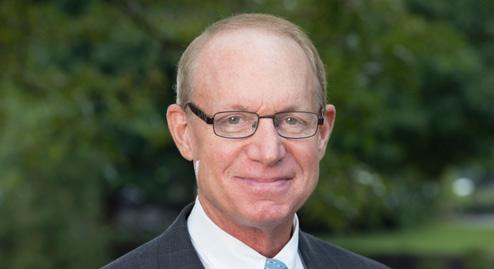
Domani Wealth joined Savant Wealth Management effective May 9, 2023. Please see savantwealth.com/savant-views-news/press-room/ for more information. Savant Wealth Management (“Savant”) is an SEC registered investment adviser headquartered in Rockford, Illinois. Past performance may not be indicative of future results. A copy of our current written disclosure Brochure discussing our advisory services and fees is available upon request or at www.savantwealth.com.
to the issue. Shortly after 9:30 a.m. on December 14, 2012, 20-year-old Adam Lanza shot through a plate-glass window next to the Sandy Hook Elementary School's locked front entrance and gained access to the school. Upon hearing the noise, the principal and school psychologist rushed to investigate and were immediately shot and killed by Lanza, who was armed with an AR15 semiautomatic rifle, two semiautomatic pistols, and dozens of rounds of ammunition. Lanza also shot and wounded two other Sandy Hook staff members.
He then entered two first-grade classrooms, where he gunned down two teachers and 15 students in one room and two teachers and five students in the other room. The children Lanza murdered, 12 girls and 8 boys, were 6 and 7 years old. Each victim had been shot multiple times. When Lanza heard the police closing in on him, he killed himself in a classroom at approximately 9:40 a.m. The entire massacre lasted less than ten minutes.
The community of Newtown decided to tear down Sandy Hook Elementary School. It was razed in the fall of 2013; a new school was built on the same site.
In the wake of the Sandy Hook Elementary School shooting in 2012, some, including President Barack Obama, called for a renewed ban on assault weapons and for tighter background checks. Others, among them the National Rifle Association,
resisted any gun restrictions as an unacceptable infringement on the Second Amendment. Meanwhile, the shootings are growing in number, as are the victims.
In 2022, a decade after Sandy Hook, there were 51 school shootings in the United States that resulted in injuries or deaths, the most in a single year since Education Week began tracking such incidents in 2018. Prior to 2022, the highest number of school shootings with injuries or deaths was 2021 with 35. There were 10 in 2020, and 24 each in 2019 and 2018. As these statistics show, the problem isn’t going away with thoughts and prayers for the victims and their families alone — it is only getting worse. The gruesome statistics from 2022, as found in an article from Education Week, are as follows:
• 51 School shootings with injuries or deaths
• 140 People killed or injured in a school shooting
• 40 People killed

• 32 Students or other children killed
• 8 School employees or other adults killed
• 100 People injured
Summer 2023 | 19 www.BERKSBAR.org
page
Continued on next
Thomas K. Williams, CFP®, CPA tom.williams@domaniwealth.com 610.927.4685
Michael J. Dinan, CFP® michael.dinan@domaniwealth.com 610.927.4685
The Second Amendment and Targeted K-12 School Shootings: An American Dilemma
Continued from page 19
A U.S. SECRET SERVICE ANALYSIS OF TARGETED K-12 SCHOOL VIOLENCE
In 2019, the U.S. Secret Service National Threat Assessment Center studied 41 incidents of targeted school violence that occurred at K-12 schools in the United States from 2008 to 2017. The report provides an in-depth analysis of the motives, behaviors, and situational factors of the attackers, as well as the tactics, resolutions, and other operationally relevant details of the attacks.

Summary of Key Findings
• There is no profile of a student attacker, nor is there a profile for the type of school that has been targeted.
• Attackers usually had multiple motives, the most common involving a grievance with classmates. Attackers were also motivated by grievances involving school staff, romantic relationships, or other personal issues. Other motives included a desire to kill, suicide, and seeking fame or notoriety.
• Most attackers used firearms. The firearms were most often acquired from the home; many of the attackers were able to access firearms from the home of their parents or another close relative.
• Half of the attackers had interests in violent topics. For example, a student who is preoccupied or fixated on topics like the Columbine shooting or Hitler, as was noted in the backgrounds of several of the attackers in this study, may be the focus of a school threat assessment to determine how such an interest originated and if the interest negatively impacts the student’s thinking and behavior.
• All attackers experienced social stressors involving their relationships with peers and/or romantic partners. Attackers experienced stressors in various areas of their lives, with nearly all experiencing at least one in the six months prior to their
attack and half within two days of the attack. In addition to social stressors, other stressors experienced by many of the attackers were related to families and conflicts in the home, academic or disciplinary actions, or other personal issues.
• Nearly every attacker experienced negative home life factors. The negative home life factors experienced by the attackers included parental separation or divorce, drug use or criminal charges among family members, and domestic abuse.
• Most attackers were victims of bullying, which was often observed by others. Most of the attackers were bullied by their classmates, and for over half of the attackers, the bullying appeared to be of a persistent pattern which lasted for weeks, months, or years.
• Most attackers had a history of school disciplinary actions, and many had prior contact with law enforcement.
• All attackers exhibited concerning behaviors. Most elicited concern from others, and most communicated their intent to attack. The behaviors that elicited concern ranged from a constellation of lower-level concerns to objectively concerning or prohibited behaviors. Most of the attackers communicated a prior threat to their target or communicated their intentions

20 | Berks Barrister www.BERKSBAR.org
to carry out an attack. In many cases, someone observed a threatening communication or behavior but did not act, either out of fear, not believing the attacker, misjudging the immediacy or location, or believing they had dissuaded the attacker.
The Levin and Madfis Sequential Model for Mass Murder at School
In its report, the Secret Service conducted an analysis into the shooting at Sandy Hook Elementary School using the Levin and Madfis Sequential Model for Mass Murder at School.
Levin and Mafis proposed a Five Stage Sequential Model to explain what might lead students to commit mass murder at their schools. Each distinct stage is hypothesized as a necessary condition, but it is the cumulative strain where these different factors intersect and build on each other that is viewed as leading to a school shooting. The five stages are Chronic Strain, Uncontrolled Strain, Acute Strain, The Planning Stage, and Massacre at School.
Levin and Madfis’s first stage is Chronic Strain. Strain includes a range of negative experiences or events in social relationships at school, home, work, or in the neighborhood where the individual resides that result in anger, frustration, disappointment, depression, fear, and, eventually, crime.
When strain becomes intense and continues for a considerable amount of time, it becomes “Chronic Strain.” Chronic Strain appears to be a major factor for school shooters as most felt bullied, threatened, or injured by others and had a history of extreme depression and difficulties coping with significant losses. School shooters often have had stressful conditions at home or school. They found that school shooters felt chronic rejection in 13 of the 15 school shooting incidents that they analyzed.
Another source of strain for school shooters can stem from interpersonal relationships at school. Middle and high school students often measure their success in life in terms of their popularity with peers and, as their research noted, most school shooters felt bullied, threatened, or injured by others. Chronic Strain alone does not lead individuals to become school shooters. Many young individuals experience these forms of Chronic Strain and do not become attackers, and so other psychologically moderating factors must be in play as well.
Levin and Madfis’s second stage is Uncontrolled Strain, during which the strains of everyday life are left unchecked by the absence of conventional and/or prosocial relationships. Although it was noted that attackers ranged from socially isolated to popular among their peers, 34% of the attackers were characterized by others as “loners” or viewed themselves as loners. In an attempt to lessen the effect of the Chronic Strain, teens may externalize responsibility for failures that can then increase isolation.
Levin and Madfis’s third stage, Acute Strain, takes place when some loss is perceived as catastrophic by the attacker. Acute Strain consists of short-term, but especially upsetting, events that seem catastrophic to an already troubled and isolated individual.
When it comes to the biggest investment in your lifetime, your experience is just as important as your agent’s. Over the last 40+ combined years in Berks real estate, the Eric Miller Team have delivered uncompromising honesty, integrity, attention, and tenacity, prioritizing their customers’ needs to give them the experience they deserve.



The Erics have mastered a blend of savvy negotiation, strategic problem-solving, and impactful marketing driven by a passion for their community. As Berks County natives, students, coaches, and playground leaders, the Erics know the area and market better than anyone. They join less than 0.5% of RE/MAX agents worldwide in the Circle of Legends, along with Hall of Fame and Lifetime Achievement status, and over $650 million sold. You know the importance of having an advisor you can trust. And so do we.
Office: 610.670.2770 • Cell: 484.269.2394
Acute Strain in the presence of long-term Chronic Strain leads the potential shooter to feel that there is nothing left to lose and leads to the fourth stage, the Planning Stage. Once the attacker decides to commit a massacre, some time is spent planning, as mass murder is not a simple criminal act. Most attackers develop a plan at least two days before carrying out the attack, and some spend much more time. For example, Eric Harris and Dylan Klebold spent more than a year preparing for their attack at Columbine High School. Time was spent obtaining and modifying guns, and their attack was timed to be on the anniversary of Hitler’s birthday.
School massacres are rarely impulsive or spontaneous attacks. School shooters also tend to not have histories of having had a mental health evaluation and to not be diagnosed with a mental disorder. This mental health background is consistent with the fact that school shooters do not suddenly “snap” and commit attacks but rather plan them out. The attack acts as a solution to the shooters’ most serious issues of damaged personal identity and self-worth. Attackers see the shooting as a means of forcing others to take notice of them. In addition, a school massacre is used as a way of asserting masculinity as much of Western culture associates violence with masculinity. Ultimately, ignored and emasculated young males believe that a massive shooting will help them regain lost feelings of power, pride, and masculinity, and may also have them achieve international attention.
Continued on next page
Summer 2023 | 21 www.BERKSBAR.org
EMiller@GoBerksCounty.com BerksCountyUpscaleHomes.com
“They truly are the top experts in buying/ selling in this area, and the best team to entrust with such an important life event. Their team is incredibly committed to making the entire selling and purchasing process go as smoothly as possible.”
The Second Amendment and Targeted K-12 School Shootings: An American Dilemma
Continued from page 21
The fifth and final stage in Levin and Madfis’s model is the Massacre at School, where certain facilitating factors must be in place. In fact, these researchers suggested that most bullied and isolated boys never commit a school shooting even if they endure Chronic and Acute Strain, and many seriously troubled teens who have considered committing a school shooting and even made plans for an attack have not carried it out.
SANDY HOOK ELEMENTARY SCHOOL
On December 14, 2012, after murdering his mother at their home, Adam Lanza fatally shot 20 children and 6 adults at Sandy Hook Elementary School before taking his own life. It was one of the deadliest school shootings in U.S. history.
On November 25, 2013, Connecticut State’s Attorney released the report on the shooting at Sandy Hook Elementary School. The report states that Adam Lanza’s motives for the shooting remain unanswered. There was no clear reason as to why he committed the shootings or why he chose Sandy Hook Elementary School as his target. Although there may not be a concrete explanation, analysis of the evidence gathered seems to fit within Levin and Madfis’s cumulative strain model which may offer possible explanations.
The first stage of the model is Chronic Strain. Details suggest that Lanza had experienced Chronic Strain at home, in school, and from his own mental health issues. The fact that Lanza killed his mother prior to the massacre at school is already suggestive of strain at home. In addition, his parents separated in 2001 and eventually divorced. Lanza’s relationship with his father deteriorated toward the end of 2010, and although his father continued to email him, Lanza stopped responding. His father remarried in 2011. Lanza’s older brother moved out of state after college and had no contact with Lanza from 2010 on.
Some reported that Lanza was close to his mother, whereas others said that he did not have “an emotional connection” to her. Lanza had sensory issues, multiple daily rituals, and eating idiosyncrasies. He changed his clothes often during the day and had issues with loud noises. Lanza never let his mother into his room to clean and communicated with her by email despite living in the same house.
Teacher reports seemed mixed about Lanza having been bullied. His father said that Lanza was bullied about his “social awkwardness and physical gait,” but it was not excessive. Lanza seemed to have few friends growing up. During his early schooling, he was described as “a nice kid, though sort of withdrawn.” Lanza’s psychological issues also constituted an additional form of strain. As far back as preschool, Lanza engaged in “repetitive behaviors, temper tantrums, smelling things that were not there, excessive hand washing, and eating idiosyncrasies,” behaviors that likely interfered with his interactions with peers.
In 2005, Lanza was diagnosed with Asperger’s Disorder and was described as “presenting with significant social impairments and extreme anxiety.” It was also noted that Lanza “lacked empathy.” Many who knew Lanza described him as “unemotional, distant, and remote.” His mother claimed he “had no emotions or feelings.”
Lanza appeared to have few interpersonal relationships, and those he did have seemed strained. His lack of social relationships leads to Levin and Madfis’s second stage of Uncontrolled Strain. His mother noted significant changes in his behavior around the seventh grade where Lanza stopped participating in activities such as the school band and playing soccer and baseball. His written work began to reflect violent themes. In fifth grade, he wrote a story in which the protagonist has a gun in her cane and shoots at people, including children. His seventh grade writing assignments were “obsessed about battles, destruction, and war, far more than others his age,” and the amount of violence in the writing was “disturbing,” according to Lanza’s teacher.
Later, Lanza appeared to become more of a loner and socially isolated. In 9th and 10th grades, he became reclusive and stayed in his bedroom playing video games all day. He played a variety of video games, some of which had violent content, and he had a computer game called “School Shooting.” Lanza had a cell phone but never used it. Mental health professionals who saw Lanza did not see any aggressive or threatening tendencies that would have predicted his later actions.
In the third stage of the cumulative strain model, the school shooter experiences an Acute Strain, which is some loss that is perceived as catastrophic by the attacker and serves as a catalyst for the shooting. Lanza’s mother had plans to sell her house in Newtown and move to either Washington State or North Carolina. Lanza had extreme anxiety along with a myriad of other mental health issues. For them to move, his mother was going to buy a recreational vehicle to help with showing and selling the house because Lanza refused to sleep in a hotel. In fact, when their house lost power after Hurricane Sandy, Lanza stayed in the house, refusing to go to a hotel. If Lanza’s overall debilitating anxiety prevented him from staying in a hotel, moving to a new house in a new state may very well have proved catastrophic for him.
When Acute Strain occurs while long-term Chronic Strain persists, the potential shooter begins to feel that there is nothing left to lose and enters the fourth stage, the Planning Stage. The evidence from the Sandy Hook Elementary School shooting indicated that Lanza had formulated a plan. Evidence indicated that Lanza had a preoccupation with mass shootings, especially the
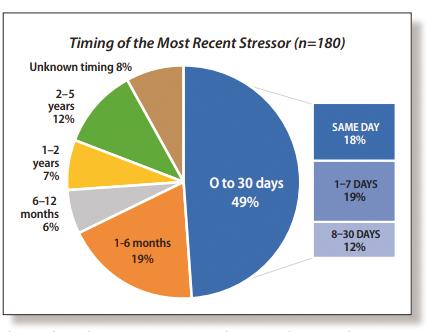
22 | Berks Barrister www.BERKSBAR.org
1999 shooting at Columbine High School. In fact, a spreadsheet listing mass murders with information about each incident was found among his possessions. He also collected newspaper articles about school shootings. Lanza clearly had a plan. He had removed his GPS from his car, used earplugs during the shooting, and purposefully damaged his hard drive.
The final stage of Levin and Madfis’s model is the Massacre at School where certain facilitating factors must be in place, specifically access to and proficiency with firearms. In an opensource database study, 80% of individuals who carried out a K-12 mass shooting stole the firearm used in the shooting from a family member. In contrast, those who committed mass shootings outside of schools often purchased guns lawfully (77%). K-12 mass shootings were more likely to involve the use of a semiautomatic assault weapon than mass shootings in other settings, but handguns were still the most common weapon used in K-12 mass shootings.
His mother had legally purchased all of the firearms that Lanza used. In fact, shooting was a family pastime. Lanza’s mother grew up shooting guns, and they enjoyed target shooting together. Lanza and his mother took National Rifle Association (NRA) safety courses. She had even written out a Christmas check for Lanza to purchase another firearm. His mother believed that “it was good to learn responsibility for guns.” Teens who commit a school shooting are most likely to obtain a weapon by theft from a family member, indicating a desperate need for more secure firearm storage practices.
Lanza’s victims were musicians and painters, swimmers and ball players, dancers and budding authors, big brothers and little sisters, and each the darlings of their parents’ hearts. They were teachers, administrators, and staff who refused to abandon their sacred trust to safeguard their tiny charges – all lost forever in a horrific rampage that haunts the nation to this day. It is my fervent hope that the second part of this article, which will concentrate on prevention of targeted K-12 school shootings, will assist Berks County Schools in avoiding any such similar tragedy.
Sources:
1) School Shootings This Year: How Many and Where (2023, January 5). Education Week. Retrieved March 29, 2023, from: https://www.edweek.org/leadership/school-shootings-this-year-howmany-and-where/2022/01.
2) https://www.secretservice.gov/newsroom/releases/2023/01/ new-secret-service-research-examines-first-time-five-years-mass violence#:~:text=%E2%80%93%20Today%2C%20the%20U.S.%20 Secret%20Service%20National%20Threat,and%20highlighting%20 the%20observable%20commonalities%20among%20the%20 attackers.
3) https://www.rand.org/pubs/tools/ TLA1613-1/toolkit/prevent.html
Mr. Wortman is principal of Justicia Law in Reading.

Get the Cure for your Desktop Printing Costs

“We’ve had excellent service from Mark at Cartridge MD. He has been able to provide the cartridges we’ve needed in a very quick and efficient manner. He has been an extreme knowledge base when recommending replacement units to meet our current printer needs.”

— Fanelli & Company, LLC – Accountants
107 Day Lily Drive Sinking Spring, PA 19608 (610) 816-7123 (no stock onsite)
Sales@CartridgeMD.com
CartridgeMD.com
ATTORNEY DISCIPLINARY AND ETHICS MATTERS
James C. Schwartzman, Esq.
• Judge, Court of Judicial Discipline
• Former Chairman, Judicial Conduct Board of Pennsylvania
• Former Chairman, Disciplinary Board of the Supreme Court of Pennsylvania
• Former Chairman, Continuing Legal Education Board of the Supreme Court of Pennsylvania
• Former Chairman, Supreme Court of Pennsylvania Interest on Lawyers Trust Account Board
• Former Federal Prosecutor
• Selected by his peers as one of the top 100 Super Lawyers in PA and the top 100 Super Lawyers in Philadelphia
• Named by his peers as Best Lawyers in America 2022 and 2015 Philadelphia “Lawyer of the Year” Ethics and Professional Responsibility Law and Legal Malpractice Law 111
Summer 2023 | 23 www.BERKSBAR.org
NO CHARGE FOR INITIAL CONSULTATION
STATEWIDE PENNSYLVANIA MATTERS
North Sixth Street • Reading, PA 19601 (215) 751-2863
consultation and expert testimony in disciplinary matters and matters involving ethical issues, bar admissions and the Rules of Professional Conduct
Representation,
Legal Spirits Luau Party!


On February 9, the Bar Association was transformed into a Hawaiian paradise for the annual Legal Spirits Happy Hour. Members joined in on the festivities and dressed up in leis and luau skirts. A rum punch and Hawaiian inspired dishes were served to enhance the feeling of an island party as members networked and caught up after the holiday season.



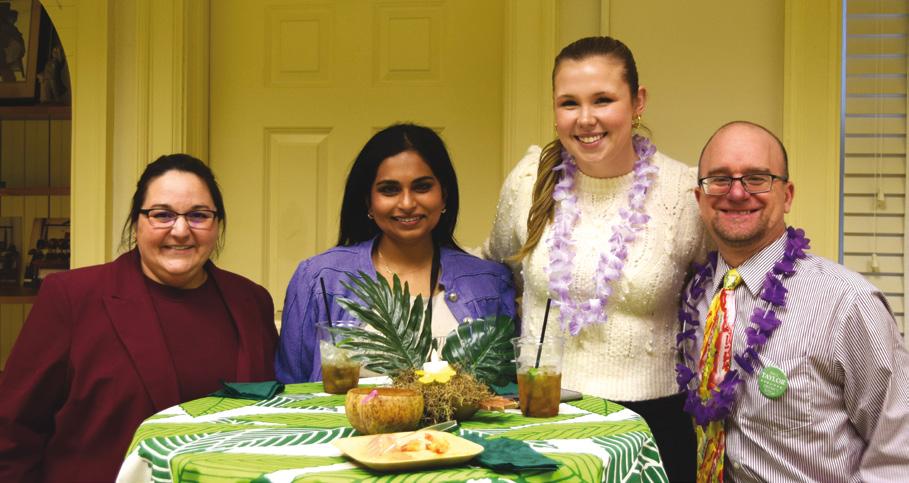
The Best Dressed award goes to Berks County Bar Association Director Sara Haines Clipp, President Gabriela Raful, Entertainment Committee Chair Julie Marburger, Mike Weider, Kelsey Frankowski, and Entertainment Committee ViceChair Matt Lasewicz.

24 |
www.BERKSBAR.org
Berks Barrister
President Gabriela Raful and Immediate Past President James Smith embraced the luau theme in their grass skirts.
Jill Scheidt and Berks County Bar Association Director Jay Kurtz match with their brightly colored Hawaiian accessories.
Berks County Bar Association
Director Amy Litinov, Dawn Tan, new member Emily Washburn, and Magisterial District Judge Eric Taylor donned bright colors and leis during the happy hour.
Jennifer Nevins, VicePresident Daniel Nevins, and Paul Marella catch up at the Legal Spirits Happy Hour.
New member Misty Toothman with 2022 Young Lawyers Section President Kourtney Bernecker and Daniel Cortes.
ST. PATRICK’S MARCH MADNESS PARTY


It was a sea of green as members celebrated St. Patrick’s Day and kicked off March Madness at The Works, Wyomissing on March 17. Members placed their bets, filled out their brackets, and played some commercial bingo while many NCAA games were broadcasted and great food and drinks were consumed. The event finished off with a game of horse as everyone enjoyed a full day of fun and collegiality!






Summer 2023 | 25 www.BERKSBAR.org
Berks County Bar Association Director Jay Kurtz and Stacey Lindsay catch up while cheering on their favorite teams.
Judith Kline of MidPenn Legal Services with husband Charlie Kubovcsak.
Kenneth Kelecic and MDJ Eric Taylor pose for a quick photo during their game of horse.
Lisa Siciliano and Andrew Fick.
Salvatore Folino, Matthew Lasewicz, and Richard Grimes spend their lunch hour watching first-round games. Matthew Lasewicz makes an impressive shot to win his round of horse.
Kelsey Frankowski, Michael Weider, Nicole Manley, Entertainment Committee Chair Julie Marburger, Entertainment Committee Vice-Chair Matthew Lasewicz, and Salvatore Folino dressed in green for the St. Patrick’s holiday.
The First Steps Towards Citizenship

Bright and early on Saturday morning, April 1, a dozen attorneys volunteered their time at the Bar Association’s first-ever Citizenship Clinic, assisting over thirty individuals begin their naturalization process by completing and filing n-400 forms. Daniel Cortes organized the clinic by screening the individuals seeking naturalization prior to the clinic, compiling all the necessary forms, and hosting a CLE to train the volunteers and answer all their questions. The Centro Hispano was a gracious host, providing ample private spaces for attorneys and clients, staff members to assist with interpreting, and endless technical support.
The volunteer attorneys celebrate a successful clinic after helping over 30 individuals begin their naturalization process.


Eric Winter meets with one of his many clients of the day, with a staff member from the Centro Hispano assisting and translating for the client.




26 | Berks Barrister www.BERKSBAR.org
Lusiamelle (Lucy) Brito, Community Services Manager at the Bar Association, assists MDJ Tonya Butler communicate with the client as they review all the necessary information that needs to be included on the n-400.
MidPenn Reading Office Managing Attorney Kathryn Wentzel (right) and Albright College pre-law student volunteer Sierra Chandler welcomed clients checking-in for the event.
Clinic organizer Daniel Cortes reviews a client’s completed n-400 before advising him on the next steps.
Shahily “Shay” Negron (right) asks her client (center) when her last trip abroad was while the client’s daughter (left) helps her mother answer the questions.
Berks County Welcomes 45 New Citizens


The Honorable Eleni Dimitriou Geishauser presided over a naturalization ceremony that welcomed 45 new American citizens on April 5 in Courtroom 5A of the Berks County Courthouse. Yvette Plant, Supervisor at the United States Bureau of Citizenship and Immigration Services, presented certificates of citizenship to the newly naturalized citizens, who originated from 14 different countries, including Ukraine and The Gambia. State Rep. Mark Gillen of the 128th District delivered remarks about his own familial ties to immigration and offered inspiring words to the newly naturalized citizens preparing them for the wondrous road that lies ahead. Many members of the community joined the celebration, including Troop 413 of Wyomissing, who presented the colors, and Miranda DeFiore of Kutztown University, who provided beautiful musical selections.




Kourtney Bernecker, Vice Chair of the Citizenship Committee, with Miranda DeFiore, soloist from Kutztown University of Pennsylvania, Class of 2023, who provided a beautiful musical assortment for the ceremony as well as a poetry selection entitled “Country of Freedom,” which she delivered in Spanish.

Orquidea Malendez Da Tiburcio, originally from the Dominican Republic, with her certificate of citizenship and mini-American flag after the ceremony.
Representative Mark Gillen, the Honorable Eleni Dimitriou Geishauser, and President Gabriela Raful, who all spoke on their personal connections with the naturalization process, the amazing journeys these individuals are beginning, and all they will be able to accomplish.

www.BERKSBAR.org Summer 2023 | 27
The 45 newly naturalized citizens, President Gabriela Raful, the Honorable Eleni Dimitriou Geishauser, Representative Mark Gillen, Yvette Plant, and community members gather for a group photo after the ceremony.
Judge Dimitriou Geishauser with Manuel Montilla Mella.
Cesar Mauro Mizhquiri (right) and his wife (left) pose proudly with Judge Dimitriou Geishauser after the ceremony.
Nini Yoanna Garay Protilla (center) with her family and friends who attended the ceremony to celebrate this life-changing achievement.
Cornerstones of Democracy: Civics, Civility, and Collaboration
Members, Berks County students, and local officials celebrated the 65th annual Law Day at the Berks Bar Law Day Luncheon on May 11 at the Reading Country Club in Exeter Township. This year’s theme was “Cornerstones of Democracy: Civics, Civility, and Collaboration.” Keynote Speaker Jim Gerlach, president and CEO of the Greater Reading Chamber Alliance and former Congressman for PA’s 6th District, reflected on his bi-partisan efforts during his tenure in the United States House of Representatives as well as answered insightful questions from the audience regarding his predictions on the future workings of our government, on both the local and federal levels. In addition, the Bar Association recognized Fleetwood High School’s Mock Trial team for winning the 2023 Berks County Mock Trial Championship; this is an impressive eighth consecutive year Fleetwood took home the Berks title. President Gabby Raful also congratulated six Berks County students who placed in the 2023 Law Day Multimedia Competition Awards: Moses Mast, 5th grader from Oley Valley Elementary School; Juliana Reinard, 6th grader from La Salle Academy; Emma Rodriguez, 6th grader from La Salle Academy; Catherine Basehoar, 7th grader from La Salle Academy; Lillian Orient, 7th grader from La Salle Academy; and Emma Byers, 7th grader from Oley Valley Middle School.



Members, Berks County students, and local officials listen as keynote speaker Jim Gerlach, president and CEO of the Greater Reading Chamber Alliance and former Congressman for PA’s 6th District, speaks on his encounters with civics, civility, and collaboration during the Fireside Chat portion of the luncheon, moderated by Julie Marburger, Chair of the Law Day Planning Committee, and Kelsey Frankowski, Vice-Chair of the Law Day Planning Committee.

28 | Berks Barrister www.BERKSBAR.org
Representative Dave Zimmerman, Representative Manuel Guzman, Representative Jamie Barton, Representative Barry Jozwiak, and Representative Johanny Cepeda-Freytiz represent Berks County at this year’s luncheon.
Director Katherine Lynch leads the Oley Valley High School Select Choir as they kick off the luncheon with a performance of the National Anthem.
Julie Marburger, Jim Gerlach, and Kelsey Frankowski after a successful 2023 Law Day Luncheon.
President Gabby Raful presents Emma Byers, a 7th grader from Oley Valley Middle School, the 1st place award for the 7th and 8th grade category in the 2023 Law Day Multimedia Competition. Emma submitted a video which explores difficulties between teammates on her field hockey team, on and off the field, how their coach allowed them to air out their issues in a safe and controlled environment, and suggests the same approach can be used with legislators as they work through their disagreements.




Rose
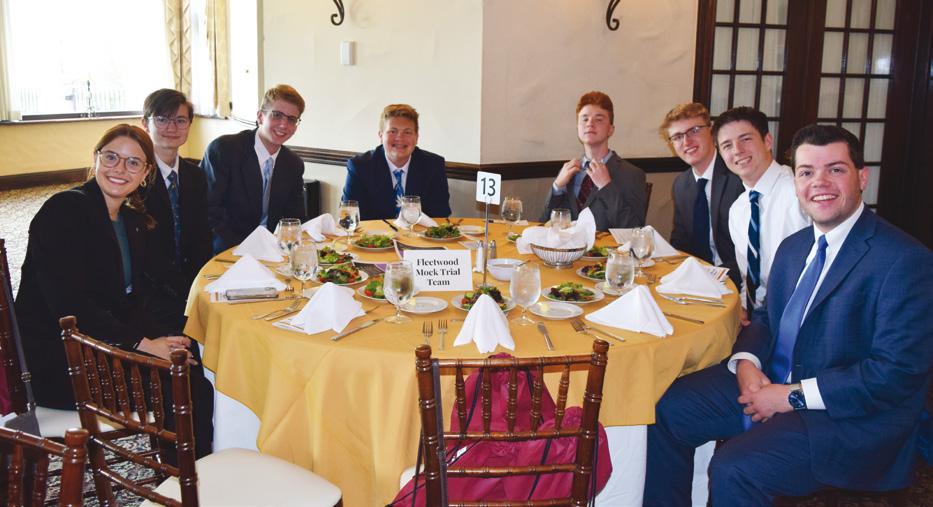

President Gabby Raful (right) presents Moses Mast (left), a 5th grader from Oley Valley Middle School his award for third place in 5th and 6th grade category in the 2023 Law Day Multimedia Competition. Moses submitted a video in which he showed how legislators can use compromise to overcome worldly conflict, such as the war in Russia and Ukraine. When Moses and his brother had a disagreement over which movie to watch, they compromised that his brother would pick the movie one week and then Moses would the next, allowing everyone to eventually achieve what they want.

President Gabby Raful with Emma Rodriguez, a 6th grade from La Salle Academy, who placed 1st in the 5th and 6th grade category in the 2023 Law Day Multimedia Competition. Emma’s submission, which discusses her and her brother arguing over who to take their new dog for a walk, is a perfect example of why overcoming conflict is so important because a lot of the time, the people arguing are not the ones hurting from the issue, someone else is.
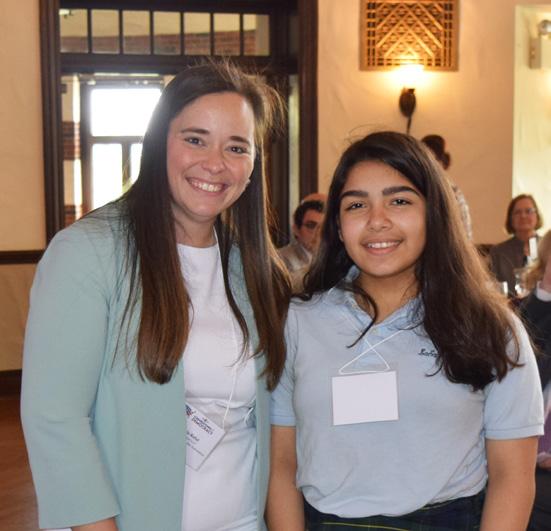
Summer 2023 | 29 www.BERKSBAR.org
Johnson, the Bar Association’s Office Manager & Law Journal Secretary, pins a commemorative Law Day pin to the lapel of the Honorable Jeffrey Sprecher to celebrate the Berks County Court of Common Pleas judges.
Members of the Fleetwood High School’s Mock Trial team celebrate their eighth consecutive win at the Berks County Mock Trial Championship.
Members pay their respect to the America flag, presented by the Oley Valley Color Guard.
(Front left, clockwise) Kelsey Frankowski, Esquire, Vice-Chair of Law Day Committee; Julie Marburger, Esquire, Chair of Law Day Committee; Pastor Steve Ohnsman of Calvary United Church of Christ, Reading; Judge Patrick Barrett; Commissioner Michael Rivera; Jim Gerlach, guest of honor; Gabriela Raful, Esquire, President of the Bar Association; Anne-Marie Grill, executive assistant to Commissioner Leinbach; Commissioner Leinbach; and Kori Walter, Executive Director of the Bar Association.
Halfway to the 15th Annual Holiday Benefit Luncheon


The Law Foundation of Berks County and the PICPA’s Holiday Benefit Luncheon, which will be held on Friday, December 1st at the DoubleTree Hotel in downtown Reading, is always a success because of the dedicated and generous group of community sponsors. The Foundation expresses its gratitude for the continuous support from local businesses, donors, and organizations with the Mid-Year Sponsor Appreciation Reception, which was held on May 16 at the Berkshire Country Club. Mickey Morandini, former second baseman for the Philadelphia Phillies and a member of the 1993 National League Champions team, stopped by to share stories about his memorable career in the MLB and his time as a Philadelphia Phillie. Special thanks to Connors Investor Services, Inc. for sponsoring this year’s Mid-Year Reception!

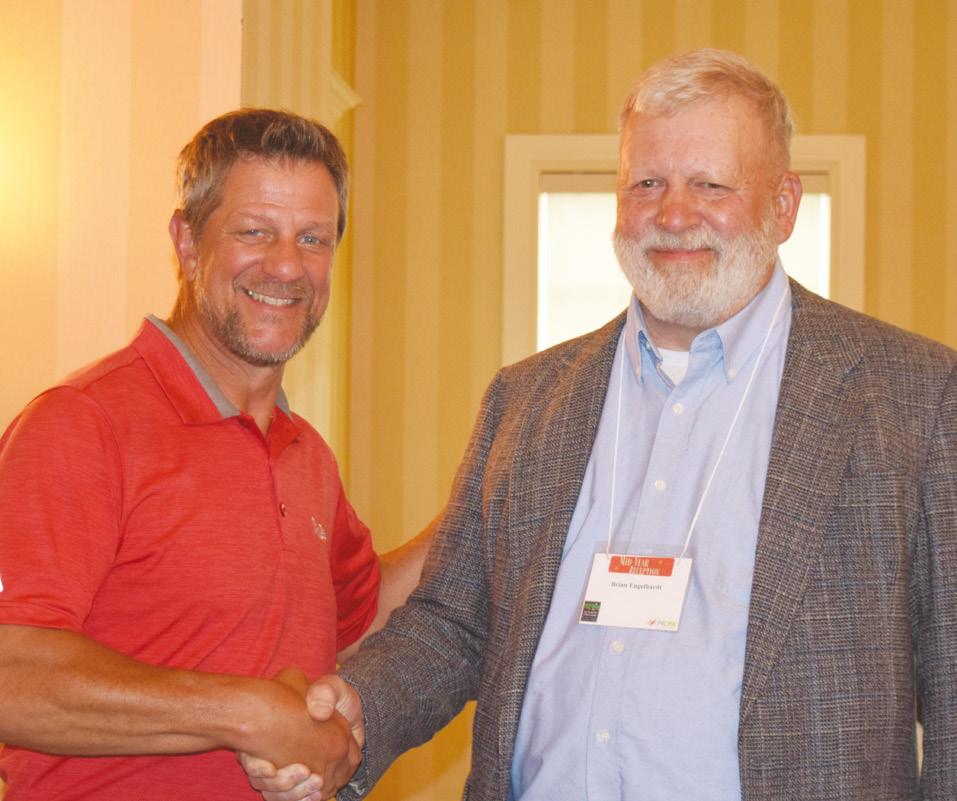


30 |
www.BERKSBAR.org
Berks Barrister
M&T Vice President John Perate, Nicole Pedriani of Univest Financial, and Dan and Ryan McCallum of Connors Investor Services, Inc. chat as the Mid-Year Reception begins.
Leadership from Members 1st, Eric Zalek, Jennifer Deck, Mioara Bosoanca, and Devon Dibiase, grab a front row table before special guest Mickey Morandini speaks.
Mickey Morandini with Brain Engelhardt after the Mid-Year Reception.
Ryan McCallum, Vice President of Connors Investor Services, Inc., thanks everyone for attending and quickly gives an overview of all the investing options Connors offers its clients before the special guest spoke. Connors was this year’s Mid-Year Reception sponsor!







www.BERKSBAR.org Summer 2023 | 31
Special guest Mickey Morandini shares the story of his first major league baseball game with the Philadelphia Phillies; he was called up from the AAA Scranton/Wilkes-Barre Red Barons only a few hours before a double-header game began in Philly. Morandini played second base for 9 seasons with the Phillies, including the National League winning 1993 team.
Morandini expresses his opinion on the new rule changes in major league baseball and his predictions on the future of baseball.
Steve Silverman, Senior Vice President of Connors Investors Services, Inc., thanks Mickey Morandini for joining the Law Foundation at this year’s Mid-Year Reception.
John Adams, Mickey Morandni, and Julia Adams.
Blyss Moyer from Members 1st chats with Morandini after he shared his baseball journey.
Law Foundation Trustee MerleDunkelberger, Mickey Morandni, and Nick Marmontello.
Taking Paths Less Traveled: One Lawyer’s Woodstock Journey
By Herb Karasin, Esquire
In August of 1969, I was living in Center City Philadelphia. I graduated from law school in 1967 and had spent a year clerking for a Common Pleas judge. I was preparing to begin a new job at Community Legal Services, which represented indigent clients in Philadelphia. A few friends had heard about an upcoming music festival scheduled to be held at Woodstock, N.Y. The exact location was actually Bethel, N.Y. We decided to go. It was scheduled to kick off on Friday, August 15. Although I don’t remember the reason, I was not scheduled to work that day. I decided to drive to upstate New York with two friends Thursday night to make sure we were there for the start of the festival. The remainder of my friends, who were working that week, planned to join us on Saturday. However, none of those friends reached Woodstock. The massive number of people trying to get to the festival clogged the roads, effectively shutting them down.
Festival promoters recommended that anyone from the Philadelphia area making the trek cross the Delaware River into New Jersey and then head north on the New Jersey Turnpike. From there, travelers were directed to take the New York Thruway. I decided to chart my own course using driving maps. For those who have never navigated using paper maps, I’d be happy to provide a history lesson any time. My disregard for the directions publicized by the festival’s organizers and my unconventional path had very little traffic and no impediments to reaching my destination. This was pure luck. And avoiding traffic wasn’t the reason I chose my route. I just like to plot my own course. But at around 2:00 AM on Friday morning, after a long stretch of road with few vehicles, we turned onto another road with bumper-to-bumper traffic. Fortunately, we had arrived! The cluster of cars were directed onto a farm field where we camped for the night. This was about a mile from the actual festival site. Back then, easy walking distance. It seemed thousands of cars were directed to that and other surrounding farm fields.
The following morning, we saw the amazing numbers of relatively freaky music fans. The feeling was one of total comfort, freedom, togetherness, and acceptance. As a lawyer and a few years older than most of those flocking to the festival, I felt I was one
of the straightest people in the sea of humanity. But everyone felt both free and in a world different from anything we had previously experienced. The feeling was exhilarating!
Everyone who had camped in the field walked together to the festival grounds. People were in various stages of dress, including weird and wonderfully colored and designed outfits. Many wore bright and varied colors, bell bottom pants, and tie-dyed shirts. A substantial number wore see-through clothing. No suits and ties or “straight” outfits.

We encountered growing numbers of increasingly freaky people. And the sense of euphoria grew as the crowd swelled. Somehow there was a feeling of communal togetherness. As we came closer and within site of the festival grounds, I saw something. At first unrecognizable, a huge moving mass. Then I realized I was looking at literally hundreds of thousands of people jammed on a farm hillside facing the large performance platform and sound system equipment. At some point the surrounding cyclone fence was smashed down by the hoards of the people trying to enter and tickets for admission became unnecessary. We joined the growing mass.
The first performer, Richie Havens, was on stage, and the crowd was responding to him. Throughout the day and into the evening, successive acts played, and the crowd became more excited and reacted. I cannot remember all of the acts individually, but the overall memory was wonderful. Janis Joplin was electric. Joan Baez performed after sunset. She asked everyone to light a match, lighter, candle or other flame, and the massive hillside was illuminated in firelight.
Over the weekend, announcements explained the details and magnitude of the event. For example, because of the crowd size, the fact that the small town we were in, Bethel, had become one of the most populated cities in the state of New York; marriage proposals were being made and announced from the stage; the fact of births of children had occurred, I believe; announcements warning of some bad drugs of a certain color being sold; and, unlikely, an announcement to thank the New York State Police for
32 | Berks Barrister www.BERKSBAR.org
its accommodating and non-threatening actions. The police were concerned that any slight perception of hostility in the immense crowd could set off an unstoppable reaction. Therefore, no arrests were made for such minor issues as drug use. Keep in mind that this leniency was unheard of at the time. Somone yelled out, “Let’s hear it for the pigs.”
Each night we walked back to the camp site in the field and our car then walked back to the festival grounds in the morning. Food, water, and portable potties for the unexpectedly large crowd were limited. We weren’t starving, but we became hungrier as the weekend passed. I decided to drive somewhere to try to find another source of food. It was pointed out that all roads were closed. Being an optimist, I expressed confidence that we could succeed, and we set off in search of sustenance. As we drove, we came across a hiking trail. The trail led into some woods. I proposed driving on the trail, assuming that it would connect with yet another road at the other end. If we reached an impassable section, I figured it would be no problem turning around and driving back. There was no fear about getting stuck and then having no chance of convincing a tow truck operator to drive down a hiking trail to retrieve my car. This was the level of rational thinking I began exhibiting in that less than rational weekend. As I reflect as a rational person, I realize I was putting my 7-year-old Oldsmobile with automatic transmission at risk. It was not built for off-road excursions.
Surprisingly, taking the hiking trail worked. We found another road in a different valley and drove to a store, bought food, and returned using the same route. We may have been the only people to leave the festival and then return.
The world changed over that weekend. One small indication of this was a comment I overheard from two young men on Sunday. One of them said, ‘Do you remember Friday when we waited until it got dark before we lit up?’ As the days passed, people were no longer waiting until dark to enjoy themselves in any way. Drugs were used and distributed openly. People walked through the crowds hawking all kinds of pills, weed, and every variety of drug.
I did not see or hear about anything about any injection of drugs, but there may have been some of that going on.
The big rain and thunderstorm which has been widely publicized happened on Sunday afternoon. It was wild and crazy. Dark clouds appeared and approached. The air temperature dropped. I remember warnings from the stage to get people down from the tall towers, which had been built to hold the vast sound system; people had climbed up to get a better view of the performers. But, thunder and lightning were coming with the storm. The grounds were already wet and muddy, but the storm, which passed through fairly quickly, left a tremendous muddy mess. As the various movies of the event have shown, many people began to run and slide downhill in the mud and otherwise play in it. Joe Cocker was performing before the storm. I decided to leave after the storm to get away from the mud, mess, and water. So we missed Jimmie Hendrix, who performed the closing act on Monday morning.
After 54 years, I can’t recall all of the musical acts. Even at the time I probably could not have listed the huge number and names of the performers. One sad thing is that I do not specifically recall seeing and hearing the Grateful Dead. The group may have performed late one night after we had left for the walk back to the camp site. At the time, I was not particularly a fan of the iconic group. That changed several years after Woodstock. I finally caught on to them. Looking back, we should have stayed to watch “The Dead” perform.
But we were “Grateful” we had experienced that historic weekend.

Mr. Karasin devoted much of his 55-year career as an attorney advocating for the underserved members of our community and was a solo practitioner in downtown Reading. He is now retired.

Summer 2023 | 33 www.BERKSBAR.org
Book Review
INVISIBLE: THE FORGOTTEN STORY OF THE BLACK WOMAN LAWYER WHO TOOK DOWN AMERICA’S MOST POWERFUL MOBSTER
By STEPHEN L. CARTER
Reviewed by Eric J. Taylor, Esquire

Here in Berks County over the last several months, two female lawyers have broken new ground. Judge M. Theresa Johnson became Berks County’s first female President Judge, and Attorney Gabriela Raful became the first Latina and minority female President of our Berks County Bar Association. I recently read about another female lawyer who, akin to Judge Johnson and Attorney Raful, was also a legal pioneer. And like Attorney Raful, this trailblazer was also a female minority lawyer; however, she worked about a century ago, when there were far fewer female lawyers.
The biography of this lawyer, Eunice Hunton Carter, was written by her grandson. Eunice, truly a trailblazer, graduated cum laude from Smith College, and she was only the second woman in the history of the college to receive both a bachelor’s degree and a master’s in four years. The New York Bar Association did not admit a black lawyer until 1929, and she became one of the first in 1933. The first black law students were not even admitted until the 1920s, and of the 535 students that enrolled at Fordham Law School in the same year Eunice did, only seven women graduated three years later. An indication of how underrepresented women were in the law school is that around the time Eunice enrolled,
a women’s bathroom had to be built. And much later in her distinguished career, Eunice became the first black woman to receive an honorary doctorate of laws degree from Smith College.
When Thomas E. Dewey was appointed to be a special prosecutor in New York to go after the mob, he hired 20 lawyers – 19 of them were white males, and Eunice was the twentieth. At that time there were maybe “a couple dozen” of female prosecutors in the entire country, and only one or two of them were black. Later Eunice was made a deputy assistant district attorney, making her the first woman to hold the post, and at $5,500 a year (in 1938), one of the highest earning black lawyers in the country.
Eunice implemented some revolutionary changes, which were later made in courts and the district attorneys’ offices throughout our country. Eunice had urged Dewey to reduce or drop charges against defendants who testified against their bosses in the prosecution of mobster Lucky Luciano, and she continued to use this innovative, yet at the time controversial, strategy, which has since been made “a permanent addition to the armamentarium of the prosecutor’s office.” It is hard for me to imagine prosecutors not utilizing this tool of offering cooperation to underlings of the

34 | Berks Barrister www.BERKSBAR.org
heads of criminal organizations. Eunice was also concerned with how the legal system treated juveniles, so she created a first in the nation system wherein those non-violent offenders between 16 and 18 years old would “in most cases have their names kept secret and be spared prison terms, in the hope of furthering their rehabilitation.” Here in Pennsylvania, this is how we treat most juvenile defendants, where we close our juvenile criminal courts to the public.


I will interject that my biggest displeasure with Invisible was that its subtitle (which is The Forgotten Story of the Black Woman Lawyer Who Took Down America’s Most Powerful Mobster), the prologue and cover of the book misled me into believing that Eunice actually prosecuted the case against Luciano, who was a prominent mobster at this time. While Eunice greatly helped in preparing and building the case and had the idea for the raids that ultimately secured the prosecution witnesses, Eunice was not the prosecutor. In fact, Eunice did not even enter her appearance in the trial. Now it is not surprising, in that era, that as a black woman Eunice was denied having a role at the trial even though she was fundamental in developing the prosecution’s case. Nevertheless, the book misled me into believing that she did. However, I have no other major criticisms about this biography and enjoyed reading and learning about Eunice’s life and the prosecution of Luciano.
Particularly entertaining in the Luciano trial were the three primary prosecution witnesses, all of whom were female prostitutes who admitted that the prosecution had threatened them with prison if they refused to testify. One of these three witnesses was a heroin addict, and at three different times during the trial, the judge allowed her to have a sip of brandy while testifying to “steady her nerves.” And although this judge had no problem with this witness drinking alcohol while testifying, the judge also granted a defense lawyer’s request that this same witness prove that she was not under the influence (presumably of heroin and not the brandy the judge allowed her to drink). So doctors examined her in another room and, after doing so, declared her to be drug free. I found it unfathomable that a judge would not only permit a witness to drink alcohol while on the stand, but also be examined by a physician to ensure her sobriety! The trial resulted in the conviction of Luciano and all nine of his co-defendants on nearly all counts, and the judge sentenced Luciano to 30 to 50 years in prison.
Eunice circulated with and was connected to many famous and influential people. Eunice was friends with Calvin Coolidge a few years before he became president. She was once on a radio show with Vivien Leigh and Laurence Olivier. Despite their differences in politics, Eunice became friends with Eleanor Roosevelt. She was also friends with future U.S. Supreme Court Justice Thurgood Marshall, as well as civil rights activists W. E. B. DuBois and Mary McLeod Bethune. And she not only worked under Dewey, but she also stumped for him in his successful campaign to become New York’s Governor and in his unsuccessful campaigns to become President of the United States.
This biography did not shy away from depicting Eunice’s flaws and an imperfect life. The author notes that Eunice was “stern and distant,” "judgmental and often dismissive”, and was “impatient.” Her marriage must not have been easy, as her husband apparently had a lot of affairs. Eunice herself may have had an affair, and she considered leaving her husband, though at that time divorces were rare in ‘better’ families. And while Eunice had only one child, she delegated raising him to others, as at various times she sent him to live in New Jersey, to a prep school in upstate New York, and to Barbados for five years, where she did not see her son while he was there for an entire year.
But these issues neither mar the person, her accomplishments, nor the book. I enjoyed reading about Eunice, whom I had never heard about previously, and about her remarkable life and accomplishments, including her role in the prosecution of the wild Luciano trial from nearly a century ago. Eunice helped pave the way for female lawyers that followed in her path like President Judge Johnson and Berks County Bar Association President Raful nearly one hundred years later. Mr. Taylor is a Magisterial District Judge serving West Reading and
Summer 2023 | 35 www.BERKSBAR.org
Wyomissing. • Audits • Policies • Cybersecurity • Cyberinsurance • Telecommunications • Social media • Marketing • Practice management • Billing and Accounting • Dictation • Document management • Computer hardware • Computer software • Networking ...and More Founded and operated by an attorney, Jeffrey A. Franklin, Esq., for lawyers, law firms, and bar associations. 10% off Audits code: BB 610-314-7130 • Info@BrightLineTechSolutions.com www.BrightLineTechSolutions.com Martin A.
Juliedy
CPA
Español julie@mdarochacpa.com 38 East Lancaster Avenue, Shillington, PA 19607 PH: 610.775.7655 • FAX: 610.775.7655 www.mdarochacpa.com Martin A. Darocha, CPA Tax and Accounting Services for Individuals and Their Businesses, Estates and Trusts. Old fashioned values and service, up to date knowledge and advice!
Darocha, CPA marty@mdarochacpa.com
Francabandera,
Hablo
Remembering a Litigating Legend
 By Donald F. Smith, Jr., Esquire
By Donald F. Smith, Jr., Esquire
Alegendary litigator, James M. Potter, died on March 3, 2023. He was 90 years old. Jim and David M. Kozloff were honored as “Litigation Legends” on March 10, 2011, as part of the Berks County Bar Association’s Legends of the Bar series. Moderated by BCBA’s then-President-Elect Frederick K. Hatt, the program featured tales of the two trial attorneys’ backgrounds and observations about the dozens of cases in which they opposed each other—Jim for the plaintiff and Dave for the defendant.


As for Jim, after graduating from the University of Michigan Law School, he joined the U.S. Army JAG Corps and was assigned to Fort Leonard Wood, Missouri. Being a young lawyer he had to begin his service as defense counsel, facing more experienced military prosecutors. “Doing battle with them had a lot to do with my learning how to litigate,” observed Jim.
In one case, the defendant had had so much Thunderbolt wine to drink that Jim argued he could not possibly have formed the necessary criminal intent at the time the offense was committed. He was acquitted! It came to be known as the “Thunderbolt Defense.”
After being transferred to Fort Mead, Maryland, Jim was elevated to prosecutor. His first case involved prosecuting a soldier charged with theft. The defendant retained a very prominent Philadelphia attorney who recruited an attorney having a background in military law as his associate for the case.
On the third day of trial, the lead defense counsel had a scheduling conflict, and the associate carried on in his absence. The next day the prominent attorney was back at counsel table but was promptly held in contempt for missing court the previous day and was placed in the stockade with a guard posted outside but having access to a telephone inside. The prominent attorney placed phone calls to the White House and a Pennsylvania U.S. Senator. Whereupon, the charges against him and his client were dismissed.
Given the treatment accorded to the Philadelphia attorney, Jim refused to serve as prosecutor in the Army again. He viewed the treatment as unprofessional, and as anyone who worked with Jim or against him in a case can attest, Jim was always professional.
36 | Berks
www.BERKSBAR.org
Barrister
Fred Hatt
David Kozloff
James M. Potter, Esq.
After his tour of duty ended in 1959, Jim took up the practice of law in Reading with his uncle, Samuel Liever, and Leroy Hyman. By September of that year, the three formed a partnership, known as the firm of Liever, Hyman & Potter, P.C.
At the time, criminal defense representation was the work of the firm. During the 2011 Legends program, Jim described finding his way to the courtrooms of district justices and aldermen throughout the county, in areas previously unknown to him. Sam Liever had an interesting way of assigning cases.

Jim recalled that, it could be 7:00 at night, and Sam would ask him to handle a hearing listed for that very night at 7:00 pm. When asked what the case was about, Sam would respond, “I don’t remember.” When asked for the client’s name, Sam would rip off a piece of paper with the name on it and hand it to him, and off Jim went.
Lee Hyman was interviewed for a BARRISTER article in 1994, and he told a similar tale. After being asked at the last minute to cover a hearing at an alderman’s office, Lee would ask “who the client would be, and Sam would respond that it will be the ‘one who doesn’t look guilty.’ When Lee would ask for the file, Sam would hand him a napkin with notes scribbled on it.”
According to Jim, this approach taught him to think on his feet.
About five years after formation of the firm, Lee began to develop a plaintiff’s personal injury practice. Meanwhile, Sam and Jim were still engaged in a highly respected criminal defense practice.
After Sam died in 1967, the firm’s focus, under Lee’s leadership, shifted more towards personal injury, but Jim was still doing some criminal defense work. In fact, during the fall of 1970, he found himself providing a defense in one of Berks County’s most infamous crimes, the Dreamland Park murders.
On August 12, 1969, Marilyn H. Sheckler, 18 years old, and Glenn W. Eckert, 20 years old, left her brother’s home in Exeter Township, never to be seen alive again. Two months later their remains were found beneath piles of heavy rocks in a hilly and densely wooded area of Ruscombmanor Township, one mile from Dreamland Park, a former, small amusement park located on Pricetown Road.
Is Berks County Community Foundation right for your clients?
If your clients care deeply about the community, support charitable causes, and hope to leave a legacy, they should learn more about the Community Foundation. We offer sound financial management of charitable funds, provide tax benefits for contributions, and ensure the causes your clients care about are supported, now and forever.

www.bccf.org
Thereafter, two members of motorcycle clans were arrested for murder. Robert Martinolich, 22, was charged with shooting Eckert, and Leroy S. Stoltzfus, Jr., 24, was charged with fatally fracturing Sheckler’s skull with a rock. Stoltzfus retained Jim to represent him.
Two court-appointed attorneys, Clement Cassidy and Joseph Nelabovige, represented Martinolich, who was the first to be tried. Following a 12-day trial, Martinolich was found guilty of first-degree murder.
Media coverage of the murders and the charges was extensive. In fact, as reported by the Reading Eagle, a preliminary hearing on November 3, 1969, “had to be moved to the gymnasium at the Millmont School because of the numerous media and curious public.”
Nevertheless, Jim’s motion for change of venue in the Stoltzfus case was denied by Judge W. Richard Eshelman.
Jury selection in the case began on September 21, 1970. The process was slow because District Attorney Robert “Tex” VanHoove wanted to make sure each juror would be willing to join in a verdict for the death penalty, if warranted. It took ten days before a jury was impaneled.
Summer 2023 | 37 www.BERKSBAR.org Continued on next page
237 Court Street Reading PA 19601 610.685.2223 www.bccf.org
Fred Hatt, left, moderates a "Legends of the Bar" discussion in 2011 featuring James Potter and David Kozloff.
Remembering Litigating Legend
Continued from page 37
Stoltzfus’s friends, James Eways and Harlin Bailey, testified against him. The two of them admitted that they had been with Martinolich and Stoltzfus and had joined in kidnapping both victims and sexually assaulting Sheckler but were not present at the time of the murders. Bailey further testified that, while he was in the county prison on other unrelated charges, Stoltzfus had confessed to him.
Interestingly, Eways and Bailey were never charged with kidnapping and sexual assault, despite testifying to having perpetrated such crimes. On cross-examination by Jim, they each denied the DA had made a deal for their testimony.
As part of the defense, Jim called Berks County Prison Warden Walter G. Scheipe as a witness. He testified that Stoltzfus had been confined to his cell following his arrest and was not allowed to mingle with other prisoners. Therefore, there would have been no opportunity for Bailey to have contact with him.
Stoltzfus tearfully testified that Bailey killed the woman and Eways murdered the man.
On October 13, 1970 the jury found Stoltzfus guilty of first-degree murder, and he was sentenced to life in prison without parole. Jim had successfully avoided him being sentenced to death.
Direct appeals followed but were unsuccessful. Stoltzfus maintained his innocence until his death in prison in 2010.
I joined the firm of Liever, Hyman & Potter in 1980. At the time, Stoltzfus had an appeal pending under the PostConviction Relief Act, claiming Jim had been ineffective in defending him. I recall, as Jim was leaving the office to testify in the matter, he turned to me and said, demonstrating his self-deprecating humor, “if only they would ask, I would stipulate to my ineffectiveness.”

Nothing could have been further from the truth. John Boccabella, now Senior Judge Boccabella, had joined the firm in the early 1970s and helped Jim with the appeal to the Pennsylvania Supreme Court, reading the entire transcript twice. He recently told me, “Jim did an outstanding job for Stoltzfus; everything he did during the trial was right on point. There was simply no way to win—the notoriety killed the case, the DA leaning on Bailey and Eways and clearly there had been a deal.”
Judge Boccabella went on to say: “That case stayed with Jim a long time, and he never really got over it. Jim thought Stoltzfus got a raw deal.” He added: “Jim considered Tex VanHoove to have been a friend and did not expect to be sandbagged by him.” According to the Senior Judge, without charges being brought against Eways and Bailey, “everyone in the community was convinced there had been a deal.”
With John Boccabella taking over the firm’s criminal and family law practice, Jim concentrated on personal injury cases. And the battles with Dave Kozloff ensued.
In a separate, more recent interview with me, Dave said, “sometimes I did a number on him but quite a few times he did a number on me. Jim had an understated approach; not flamboyant, always prepared.”
He added, “when we were trying a case, Jim was always in the courtroom before I arrived. By the time I walked in, he had his papers organized on counsel table. Ready to go.”
Dave shared an interesting observation. “Jim never wore a white dress shirt while trying a case. It was always a blue one.” During the Legends program, Jim explained, “I would not wear white because then I would look more like a lawyer and jurors do not like lawyers.”
Dave told me that Jim’s “low key approach with his everyman appearance seemed to build a rapport with the jury.” At the Legends program, he described Jim as being “quiet, unassuming” and creating an “almost irresistible appeal to the jurors because he was so nice.”
At the end of the 2011 event, Dave expressed gratitude to his long-time opponent and friend. “Jim and I have had a long and interesting career trying cases. I have learned a lot from a lot of lawyers over the years, and Berks County is fortunate indeed to have and to have had outstanding, talented, honorable and distinguished attorneys and trial attorneys, but I learned as much if not more from litigating against Jim as I have from any other lawyer I can think of. Thank you, Jim.”
Jim did not retire from practice until he was 82 years of age. In fact, at age 76 he achieved the highest verdict ever given in a soft tissue case in Lehigh County. He possessed a winning style.
That winning style can be attributed in large part to preparation starting months in advance of trial, according to John R. Badal, who practiced with Jim in the firm longer than anyone else, even longer than Lee Hyman. “As a result, Jim never felt tremendous pressure on the eve of trial. On a Sunday, the day before the start of a trial, he would be playing a round of golf, at a time when I would have been climbing the walls.”

38 | Berks Barrister www.BERKSBAR.org
John added, “while Jim had a cool, calm exterior, he was a strong advocate, being very involved with the client’s cause. He had developed an emotional attachment to the client and the client’s case.” Though low key and unassuming, there was passion in his presentation.


Despite his hard work on behalf of clients, Judge Boccabella noted that “Jimmy was super involved in the bar association. Just a great guy.” He was president of the Berks County Bar Association in 1985 and served many years on the Local Court Rules Committee, even chairing it for a term or two.

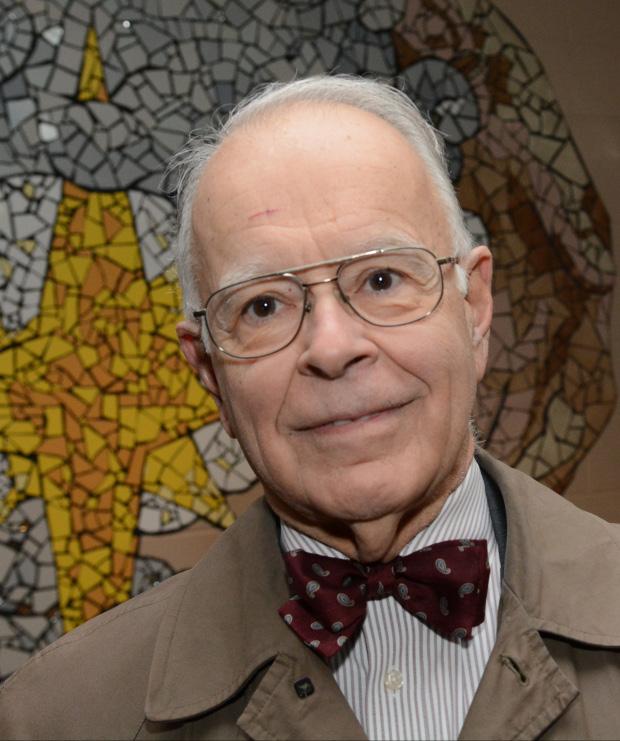

But it was not all work and no play. Jim was an avid golfer. Introducing Jim at the Legends event was Jack Mancuso, who told the gathering that Jim “plays golf 8 or 9 days a week.” Just a slight exaggeration.
Jack noted that Jim was always looking for a driver, iron, wedge or putter that would improve his game and was buying a club every “three to four months” to the point that “his basement was packed with golf clubs” such that “Dick’s Sporting Goods is a distant second in the number of clubs they have compared to Jim.”
Over the years, Jim was a member of several golfing clubs, most recently at Moselem, where I was a social member. The last time I saw Jim at Moselem he was leaving the Pub with a friend to start their round. The bartender yelled, “have a good day.” To which Jim responded, “how can I have a good day, I’m playing a round of golf.” Another example of his self-deprecating humor. He always had a good day on the course.
Jack Mancuso had frequently been his playing partner. Jack recently told me, “Jim was a steady and consistent golfer, straight and in the fairway all the time. Even if he hit a bad shot, he never became angry. Playing a round was always a day in the sun for him.”
As our interview came to an end, Jack shared, “Jim was a very special man. A quiet leader, one who would do anything for you. He was the best.”
His wife of almost 60 years, Jean, survives as do his two daughters, Amy Dietrich, wife of Randy of Exeter, and Leslie Kaltenbach, wife of Rich of Berkeley Heights, NJ, along with five grandchildren.

To conclude the Legends presentation, moderator Hatt said, “Jim and Dave, you have earned respect from everyone. Thank you for all you have done for the bar, for the profession and your clients.”
Indeed. And I might add: Jim, thank you from all of us attorneys you mentored so well, for always being available to provide advice and for being a role model.
Author’s notes: A DVD of the March 10, 2011 Legends of the Bar program is available for viewing at the Bar Association Building.
Facts pertaining to the Dreamland Park Murders were gleaned from a Reading Eagle article published on August 13, 2019. Mr. Smith was a member of the firm of Liever, Hyman & Potter, P.C. from 1980 through 2008. Thereafter, he served 10 years as Berks County Bar Association’s executive director.
www.BERKSBAR.org Summer 2023 | 39
PAMELA L. VANFOSSEN PVanfossen@MasanoBradley.com Suite 201, 1100 Berkshire Boulevard ◆ Wyomissing, Pa 19610 610.372.7700 ◆ Fax 610.372.4865 A PA Limited Liability Partnership
Bench-Bar

Over 250 members, presenters, and community sponsors attended the 2023 Bench-Bar Conference at the DoubleTree Hotel in downtown Reading on April 19. The conference was comprised of 19 courses over four tracks—criminal, civil, family, and potpourri—giving everyone a unique and interesting course to attend, no matter their practice area. This year’s plenary course, “Improving Juror Diversity and Participation,” featured Chief Judge of the United States District Court for the Eastern District of Pennsylvania Juan Sánchez and the Honorable Jeffrey Schmehl, federal judge for the Eastern District of Pennsylvania, to highlight the importance of fulfilling and promoting jury duty so every individual is able to receive a fair trial by a jury of their peers. The highlight of the day was the mid-afternoon ice cream break from the Great American Creamery!

Members of the bench and the bar partnered with APOC to bring awareness to autism spectrum disorder (ASD). April is national autism awareness month.

Members listen intently as Judge Eleni Dimitriou Geishauser, District Attorney John Adams, Judge Patrick Barrett, and Chief Public Defender Glenn Welsh discuss developing issues of concern in the criminal court division during the Criminal Bench Roundtable.
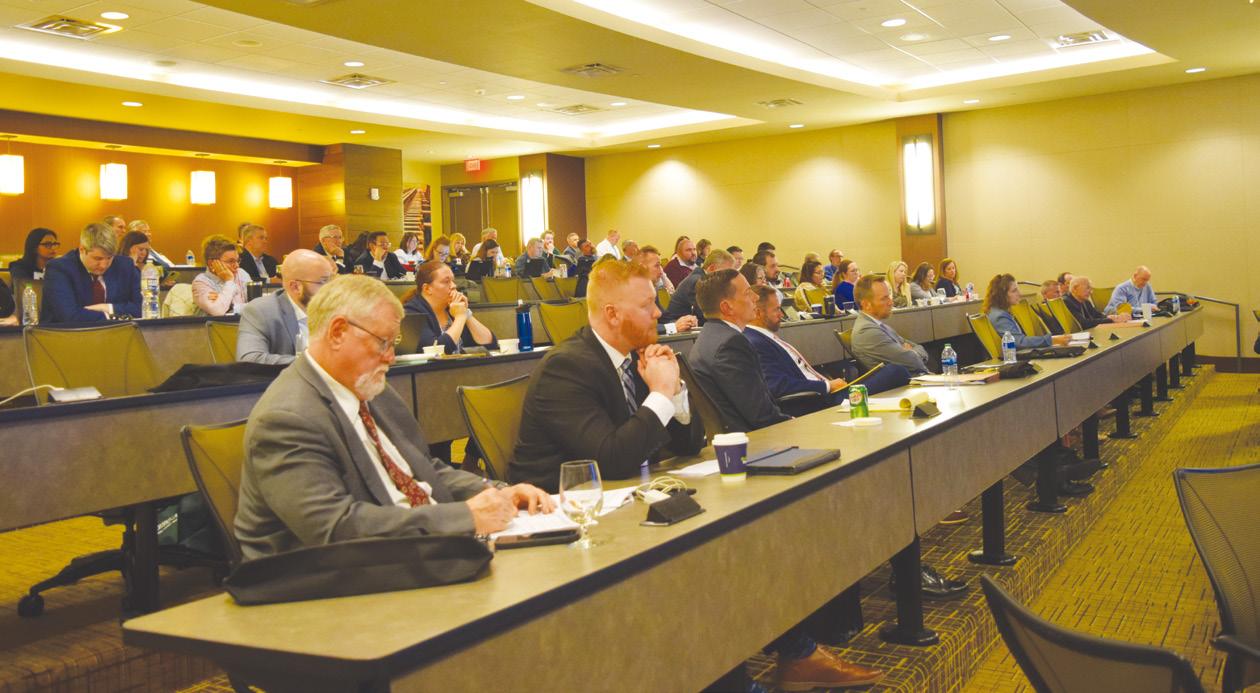
40 | Berks
www.BERKSBAR.org
Barrister
Conference


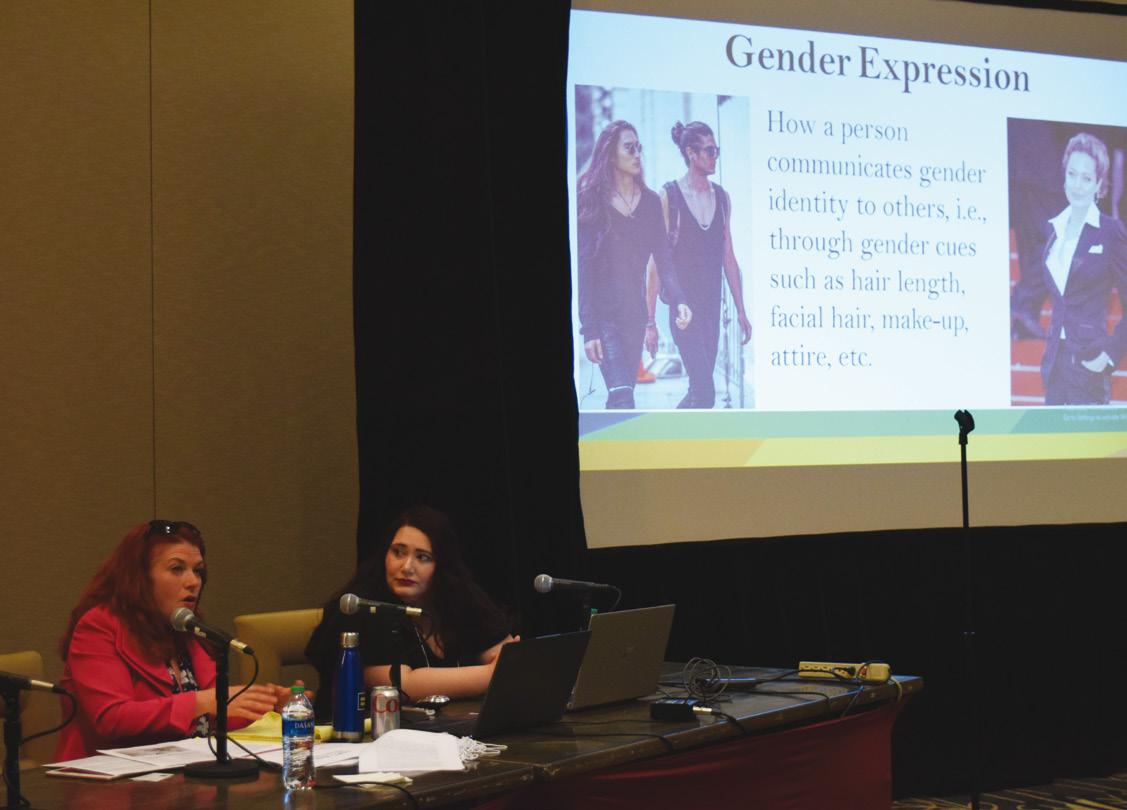

Chief Judge of the United States District Court in the Eastern District of Pennsylvania Juan R. Sánchez, the Honorable Mark. A. Kearney, Judge for the Eastern District of Pennsylvania Jeffrey L. Schmehl, Jury Supervisor for the U.S. District Court for the Eastern District of Pennsylvania Paul Lombardi, and President Gabriela G. Raful before the plenary session Improving Juror Diversity and Participation.

Continued on next page

Summer 2023 | 41 www.BERKSBAR.org
Erica McKerns, instructor for the Mindfulness for Lawyers and Judges seminar, leads members through some breathing and stretching exercises to use to alleviate stress that stems from working in the legal profession.
Lois M. Vitti of Vitti Law Group in Allegheny County and Tasha Santiago, Director of Education at the LGBT Center of Greater Reading, present the ways the which the law constructs and regulates gender and sexuality during the LGBT+ Law and the Road Ahead seminar.
Ryan S. Meyers, Deputy Director, Administration and Outreach for Pennsylvania Commission on Sentencing delivers updates to PA’s sentencing guidelines for attorneys practicing criminal law.
Lewis Guy Hall, Katherine Lekh, Jeffrey Bukowski, and Immediate Past President James Smith—all of Smith|Bukowski—at the cocktail party.
Bench-Bar Conference


Continued from page 41
During the seminar “Today’s School Boards: Curriculum, Books, and Culture,” Dawn Palange, Esquire, a Governor Mifflin School Board Member; school solicitor Brian F. Boland, Esquire; Jeremy Samek, Esquire, Senior Counsel with Independence Law Center; school solicitor John Miravich, Esquire; and Joan London, Esquire, discuss the respective rights and responsibilities of students, schools, and parents, and the dynamics of board meetings.

A Bench-Bar favorite, Paul C. Troy, Esquire, kicks off the conference with the seminar Avoiding Malpractice, which addresses issues related to avoiding professional liability.



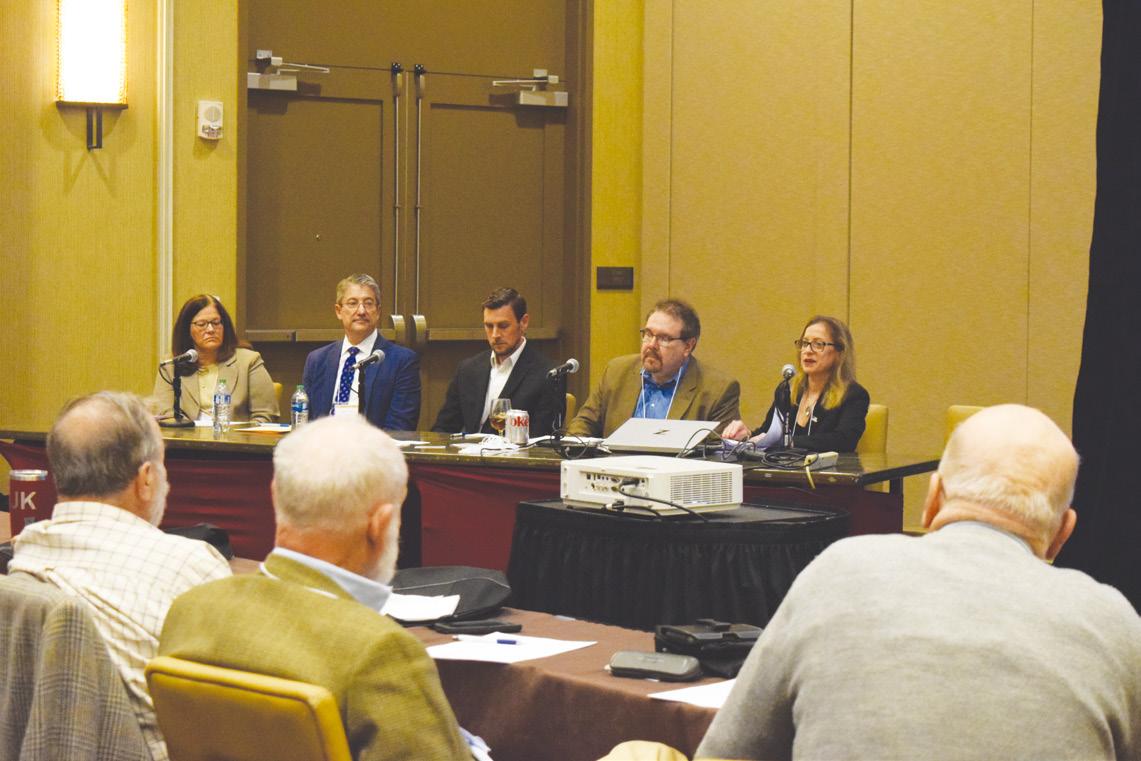
42 | Berks
www.BERKSBAR.org
Barrister
Amy Leed and Gina Curran of Stewart Abstract of Berks County, the sponsor of this year’s cocktail reception.
Graziella Sarno visits Jody Campbell of Minnesota Lawyers Mutual Insurance, Bench-Bar Partnership sponsor.
MDJ Gail Greth; MDJ Carissa L. Johnson; MDJ Eric J. Taylor, Esquire; and MDJ Tonya Butler, Esquire, provide insightful tips on how to present a case in a Magisterial District Court.
Julia Adams and District Attorney John Adams.
Members of the family law section enhanced their ability to handle every divorce scenario possible by attending the seminar Bizarre Divorce Issues, which reviewed uncommon divorce issues, including joinder of parties, valuating and dividing pensions, and cryptocurrency.



Judges from the Berks County Court of Common Pleas Civil Division are joined by Civil Litigation Section Chairs Thad Gelsinger and Jeffrey Bukowski to discuss new Civil Court procedures following the COVID-19 pandemic. (from left) Judge James Gavin, Civil Litigation Co-Chair Thad Gelsinger, Judge Madelyn Fudeman, Judge James Lillis, Judge J. Benjamin Nevius, Judge Jeffrey Sprecher, and Civil Litigation Co-Chair Jeffrey Bukowski.
Franki Aitken, COO of Berks County Community Foundation, a partnership sponsor of this year’s Bench-Bar; President-Elect Karen Cook, and President Gabriela Raful catch up after the conference.


Colin Boyer, Michael Kochkodin, and Jeffrey Franklin enjoy the cocktail party after a long day of presenting and attending seminars.

Members take a well-deserved afternoon break with ice cream from the Great American Creamery.

Summer 2023 | 43 www.BERKSBAR.org
Bistro Barberet

26 E. King Street, Lancaster
https://26eastlancaster.com/ barberet/
A chef who’s perfected more than pastry
By Susan N. Denaro, Esquire

Some food reviews are harder to write than others. It’s not that finding the right words proves difficult, it is more that some restaurant finds are so special I struggle with whether I truly want to share them with others. But when it comes to Bistro Barberet and Bakery, 26 E. King Street, Lancaster, PA, owned and operated by Cedric and Estelle Barberet, the secret may already be out.
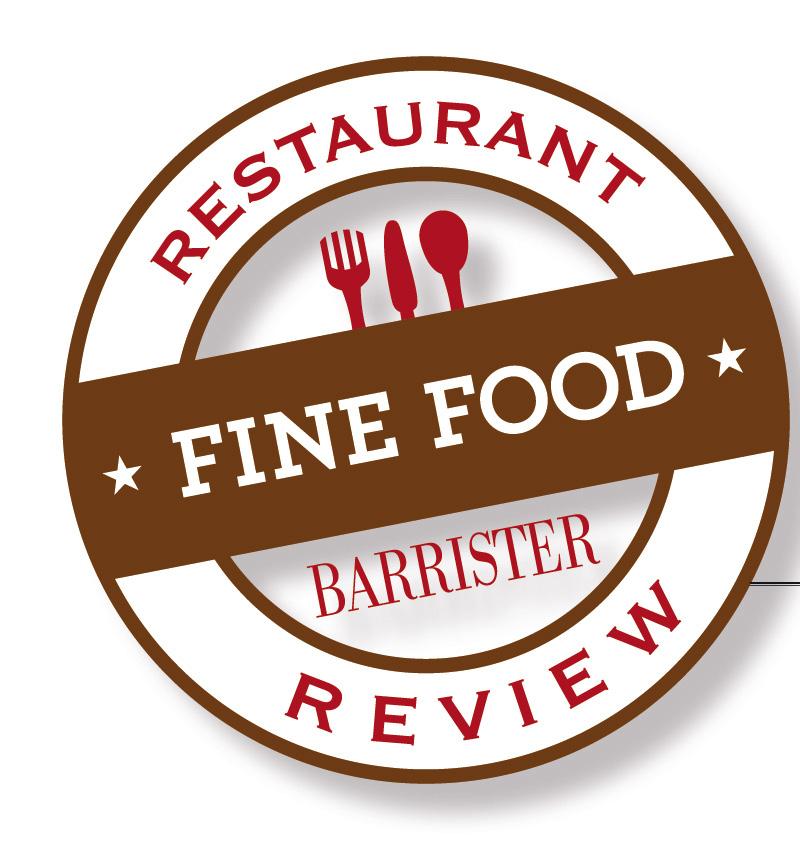
A highly accomplished restauranteur and pastry chef, Cedric Barberet’s culinary skills have garnered him national and international attention. This past winter, the prestigious Academie Culinaire de France named Cedric Barberet an Honored Academicien. A few years prior, he was named a Chevalier de l’Order du Merite by the agriculture minister of the French government. In 2016, he was named one of the top 10 pastry chefs in the US by Dessert Professional Magazine. Prior to opening his own establishment, Barberet was an executive pastry chef for Philadelphia’s infamous Le Bec-Fin, and in 2005, he was the pastry chef at Mar-a-Lago where he eventually made the wedding cake for Donald and Melania Trump in 2005. Finally, in April 2020, he won the Food Network’s “Chopped Sweets” competition.
Despite all his award-winning pastry skills, what impressed me more was the fare served in his bistro. I only learned about this place from some likeminded foodie friends, and we tripped across the county line for lunch one sunny Friday to gauge his culinary skills for ourselves. I was smitten from my first bite of his Quenelle de Brochet appetizer. For the uninitiated, quenelles are pillowy fish cakes. Barberet’s version featured Gruyere cheese and fresh herbs in a shrimp Creole sauce. I was served my first quenelle in a four-star Michelin restaurant in the Loire Valley in 2001, my most memorable meal from that trip, but Barberet’s version surpasses it by every metric. While the addition of the cheese and the larger size and shape of his quenelles surprised me, compared to the traditional versions I’ve enjoyed elsewhere, the real stunner of the plate was the savory red sauce that perfectly showcased the delicate flavor of the fish; it is a must-have for anyone who enjoys fish.
If you like foie gras, another appetizer that should not be missed is the Terrine de Foie Gras, which is served with toasted brioche points and a smear


44 | Berks Barrister www.BERKSBAR.org
These pillowy fish cakes, known as quenelles, feature Greuyere cheese and fresh herbs in a Creole sauce.
The House beetroot cured smoked salmon and other dishes offer an innovative twist on French classics.
of homemade berry jam. These three elements combined for the most decadent starter I’ve enjoyed in years; the good news is that there are slices of the terrine, jars of the jam, as well as loaves of the brioche available for carry-out in the pastry shop.

During that first visit, I devoured a chilled zucchini soup that was dotted with fresh herbs and pickled shallots; it was good to the last drop. When I returned for dinner about a week later, I inquired about another cup of it and was told that because it was a soup du jour there was no guarantee when it will appear on the menu again. Quelle dommage! That just means I will have to return again and again in search of it.
For dinner during my second visit, I was delighted by an entrée that boasted a smooth Jerusalem artichoke puree topped with a properly cooked salmon fillet and roasted Brussel sprouts. Julienned apples slices garnished the creation, and again, I was transcended by the delicate flavors back to another salmon dinner I enjoyed in a small bistro in Lemans during that same trip to France in 2001. Thanks to the perfect sear on this skinless piece of salmon in contrast to the cool crispness of the apple garnish, this dish was a stunner.
Because you can’t dine at such a renowned pastry chef’s restaurant without having dessert, we enjoyed his award-winning floating island. Barberet’s version of this olde time classic that was said to be a favorite dessert of French chef Julia Child, had a rich crème anglaise sauce that made one consider licking the plate clean. It was topped with crushed freeze-dried raspberries and a gorgeous spun sugar swirl that elevated it beyond expectation. It too was better than any version I remember eating before and is worth every calorie.
Aside from the food and atmosphere evoking memories of that long-ago sojourn to France, the true fun of dining in


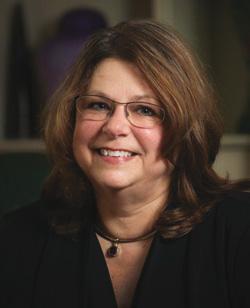

this bistro was being there with culinarily intrepid friends who all intentionally ordered something different, and by trading bites, we were able to sample more of menu items beyond our individual orders. From the beef tartare to the smoked salmon and the mussels with pommes frites to the risotto, each bite held an innovative twist on a French classic, reminding us that Cedric Barberet is more than just a genius with pastry.
I would be remiss if I didn’t mention that not only does Bistro Barberet have some reasonable prix fixe options that allow you to take your dessert home, it has a very inventive cocktail menu. If you like the flavor combination of anise and pear, the Ricard’s Star 13 will have you feeling like you’ve been transported to a sidewalk café on Paris’ left bank. If licorice is not your preferred flavor, there is a pineapple and raspberry-based French martini that is also lovely.
The other great thing about this Bistro is that you enter and exit through the pastry shop where proper croissants, perfect canelés, and other jewel-like desserts are all on sale for carry out. I have been known to complain that croissants with the right level of flakiness are not to be found in the States, but Barberet’s have made me thankfully eating my words. Do not leave without grabbing a few for breakfast the next day. I have to admit that after just those two visits, Bistro Barberet has replaced a few of my favorite regular haunts on my go-to list, but let’s try to keep this special place a secret just between us.
Summer 2023 | 45 www.BERKSBAR.org
Ms. Denaro is with the Wyomissing law firm of Georgeadis||Setley.
You’ll want to lick the plate after finishing this awardwinning floating island dessert.
Terrine de Foie Gras with toasted brioche points and a smear of homemade berry jam.
Grab some desserts to-go on your way out of the restaurant.
What You Need to Know Before Gifting Money to Family
By Tom Williams, CFP®, CPA, Financial Advisor


It’s common for parents to put the needs of their children ahead of their own. But while their generosity is admirable, gifting too much or in the wrong way can cause unintended consequences.
According to a recent Bankrate study, 43% of surveyed parents said they have sacrificed their own retirement savings to help their adult children. A July 2020 report by Edward Jones and Age Wave found that 71% of surveyed retirees were willing to offer financial support to their family, even if it meant jeopardizing their own financial future.
If you are considering gifting money to your children, keep these considerations in mind:
#1. Don’t Overcommit
Think through the long-term implications of making gifts, particularly larger amounts. If helping one child could be construed by your other children as an invitation to ask for the same, make sure you can truly afford to gift that same amount to all your kids. Talk to your advisor first to ensure your gifts are reasonable, and don’t compromise your own financial freedom.
#2.
Set Boundaries on Supporting Family Members
If a family member asks for help paying their bills or supporting their small business, make sure you have clear discussions about how far your support will extend. Can you better structure the financial support as a loan instead of an outright gift? Have you set clear boundaries upfront about what is and is not an acceptable amount of support down the road?
#3.
Structure Gift Giving Appropriately
Keep in mind the 2023 tax rules for gift-giving. Every taxpayer can gift up to $17,000 per person, per year. This is called the annual gift tax exclusion amount. A married couple filing jointly can each give $17,000 ($34,000 total) to the same person in one year with no gift-tax reporting consequences.
If the amount given to one person exceeds $17,000, you must file a gift tax return. That’s because gifts larger than the annual exclusion amount count toward your lifetime gifting limit, which, under the 2023 IRS rules, now stands at $12.92 million. Filing a gift tax return allows the IRS to keep track of your lifetime gifts. When you make a gift of over $17,000 to one person in one year, you must file a gift tax return, but you won’t owe any gift tax unless you hit the lifetime limit amount.
If you’re working with a CPA to file your taxes, making gifts of more than $17,000 to one person can result in additional tax preparation costs. If you can afford to gift more than $17,000 to one person (please talk to your advisor before doing so), try to structure the gift by giving $17,000 this year and another gift the following year to avoid the need to file a gift tax return.
If your child is married, consider splitting a larger gift by giving only $17,000 to your child and any additional amounts to her spouse. And be sure to write separate checks to her and her spouse so that you have proof of only giving within the annual gift tax exclusion amount to each person.
#4. Consider Loans as an Alternative Way to Support
If you are not sure you can truly afford to give money outright, consider structuring a loan to a family member in need.
For example, if you wish to help your daughter start a business, you could choose to provide some part of what she needs by loaning her the funds. Execute the loan in writing with clearly spelled-out terms. A family loan should carry an interest rate that is at least as high as the Applicable Federal Rate (AFR), which is published monthly by the IRS. Your interest payments received must be reported as income. Structuring the financial support this way serves the dual purpose of helping a family member while ensuring that your money will be paid back to support your own needs in the future. It also ensures that the loan won’t be deemed a gift and subject to the gift tax reporting requirements.
While it’s commendable to prioritize a child’s needs, be sure you can do so without compromising your own financial future.
This is intended for informational purposes only and should not be construed as personalized financial advice. Please consult your financial professional regarding your unique situation.
46 | Berks Barrister www.BERKSBAR.org
ADVERTORIAL When at their most vulnerable, your clients need a personal injury lawyer they can trust. With more than 40 years of experience, Dan will work to make sure your clients receive the help they need. 3 Auto Accidents 3 Construction Accidents 3 Premise Accidents 3 Insurance Disputes 3 Product Liability 3 Wrongful Death Free Initial Consultation • No Recovery, No Fee 610.478.2002 l www.personalinjurypros.com Daniel E.P.
Refer your matters with confidence.
Bausher, Esq.
GUESSING THE VALUE
By Donald F. Smith, Jr., Esquire
How does one place a value on pain and suffering?
That is the challenge we require of jurors contemplating a verdict in a personal injury case. Unfortunately, in Pennsylvania, an attorney is not permitted to argue for a specific dollar amount for noneconomic damages during closing argument.
When I closed to a jury, I struggled to give a monetary meaning to the pain suffered by my client without suggesting a figure or a formula. I am not alone. John J. Speicher, Esquire, a past president of our Bar Association, successful trial attorney for over 46 years, and esteemed story teller, told me “when arguing for pain and suffering damages, it felt like I had one arm tied behind my back.”
Therefore, an essay published in the October 2022 issue of the Pennsylvania Bar Association Quarterly caught my eye. Its title says it all: “Keep Them Guessing: Pennsylvania’s Prohibition on Counsel Attempting to Quantify Pain and Suffering Damages.”
The article, by Chad Pace, a PBA member living in Nevada, traces the history of the prohibition, provides a critical analysis, reviews the law in other states and suggests a future approach.
The prohibition dates back to 1893 when the Pennsylvania Supreme Court ruled in Himes v. Kiehl that an item of noneconomic damage “was essentially a matter to be determined upon all the evidence, and by the jury alone. The plaintiffs had no right to arbitrarily say that it was any fixed sum.”
The rule has been followed ever since, forcing plaintiff attorneys to attempt creativity. For example, the 2014 Superior Court decision in Nelson v. Airco Welders Supply involved claims under the Wrongful Death and Survival Acts. As part of his argument, counsel displayed the verdict sheet to the jury, noting the listing of the elements of noneconomic damages, seven under the Survival Act and another five under Wrongful Death.
Counsel then emphasized the parties had “agreed that the economic losses that you can accept equal $1 million. I repeat, $1 million, and that’s where you start at.
You start there.” He argued, “Each of those elements of damages starting at physical pain are worth infinitely more than that $1 million figure.” Continuing, counsel described the loss to the decedent’s wife and suggested “this number should be significant and substantial. This should be more so. Much more than this.”
The trial court had no problem with the argument, denying the defendant’s motion for a mistrial. The jury awarded a total of $12 million in noneconomic damages. On appeal, though, the Superior Court found counsel had “provided the jury with a formula to calculate damages and an
Attorney Speicher shared, “on multiple occasions, jurors came to me and said, ‘You did not tell us what you wanted for pain and suffering.’” See, they expect guidance.
He followed up with an interesting observation: “My best pain and suffering awards occurred when the jury obviously disliked the defendant or defendant’s counsel.” Thereby proving that the appellate courts have no clue as to what “evidence” the “impartial acting voice of the community” relies on without counsel’s help.
What have other states done?
According to Mr. Pace, New Jersey, by court rule, permits a request for “pain and suffering damages pursuant to a per diem formula.” In Delaware, the Supreme Court allows counsel to suggest various figures, considering it to be a “rhetorical argument” and not “a prohibited mathematical formula.” The courts in Virginia and North Carolina permit counsel to ask for a fixed dollar amount if it is supported by the evidence.
The author concludes Pennsylvania should allow an argument “that the noneconomic loss for a particular time period (often an hour or a day) can be quantified at a (usually small) monetary value,…[multiplying] the per diem figure out into the future.” I like it.
amount to plug into that formula.” Thus, it held, “clearly, counsel’s remarks were inappropriate.” So much for creativity.
Gee whiz, counsel had not argued “arbitrarily” for “any fixed sum” as the Himes court found to be problematic. Suggesting a formula is as much an error as arguing a fixed sum. Recently, in 2021, the Superior Court cited prior case law for the proposition: “[N]oneconomic loss must be measured by experience rather than any mathematical formula…For this reason, the law entrusts jurors, as the impartial acting voice of the community, to quantify noneconomic loss and compensation.”
Entrust? By prohibiting advocacy providing guidance, can the jury be entrusted to do anything but guess?
Will our Supreme Court change course after 130 years and permit such an argument? After all, we are dealing with court precedent, not a court rule or a law. The Plaintiff’s attorney must roll the dice in a case, expend the money for a losing appeal to the Superior Court and then hope for allocator in the face of overwhelming, opposing precedent. Even if successful in having the appeal accepted, persuading a majority of seven skeptical justices is then required. Isn’t it easier to settle the case?
Yes, but our current Court is more progressive; now may be the time to seek change. Justice demands jurors be given the guidance they desire by unleashing the arm behind counsel’s back.
Mr. Smith is Executive Director Emeritus of the Berks County Bar Association.


Summer 2023 | 47
www.BERKSBAR.org
Some of your most important connections
can be
found
close to home
We’re proud to put Berks County first for 30 years, and we’re committed to helping you build on your success with a financial strategy that’s just for you.

www.fa.ml.com/maggs
Merrill Lynch, Pierce, Fenner & Smith Incorporated (also referred to as “MLPF&S” or “Merrill”) makes available certain investment products sponsored, managed, distributed or provided by companies that are affiliates of Bank of America Corporation (“BofA Corp.”). MLPF&S is a registered broker-dealer, registered investment adviser, Member SIPC and a wholly owned subsidiary of BofA Corp.
Investment products: Are Not FDIC Insured Are Not Bank Guaranteed May Lose Value © 2022 Bank of America Corporation. All rights reserved.
MAP4264787 | MLWM-245-AD | 470950PM-0322 | 03/2022
Maggs & Associates Merrill Lynch Wealth Management 985 Berkshire Blvd. Suite 200 Wyomissing, PA 19610 610.320.5462















































 By Douglas Wortman, Esquire
By Douglas Wortman, Esquire









































































 By Donald F. Smith, Jr., Esquire
By Donald F. Smith, Jr., Esquire






































































